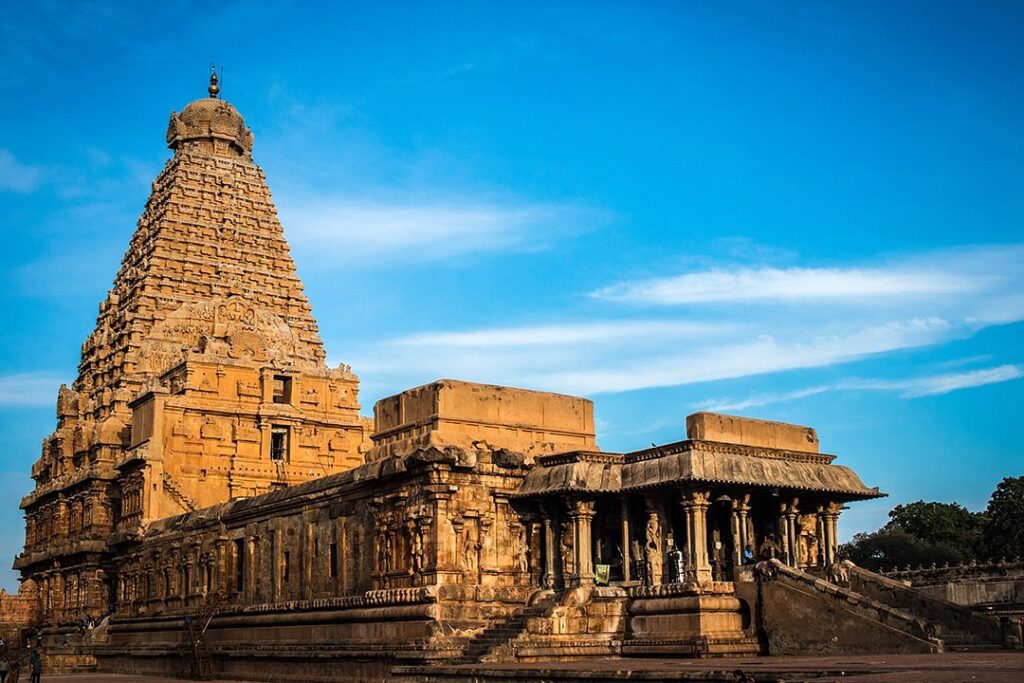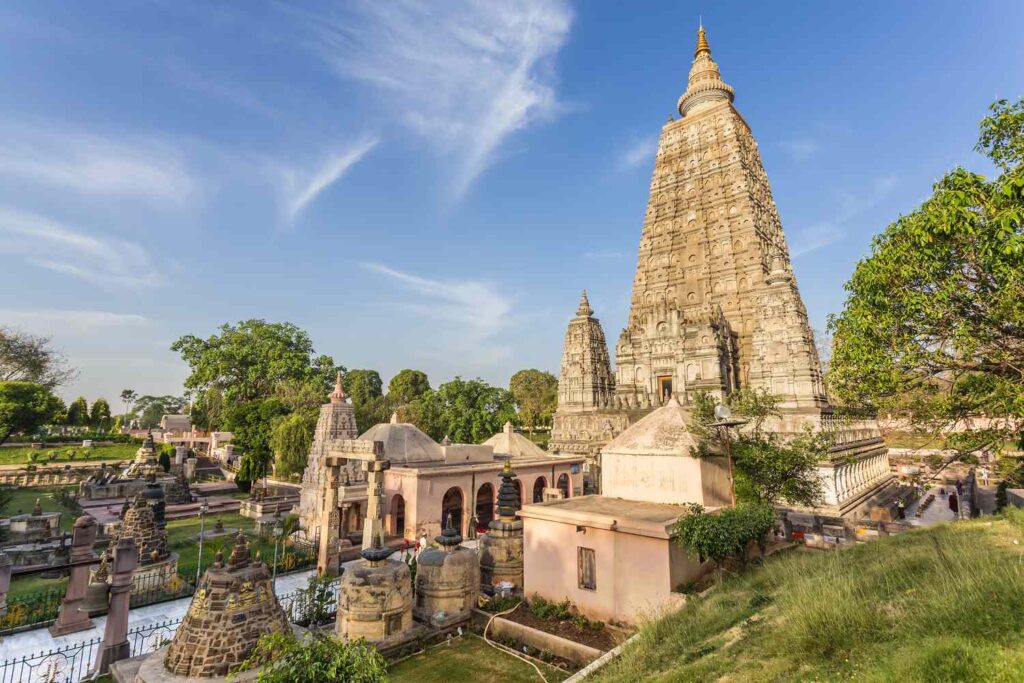India boasts a rich tapestry of spiritual heritage, and its Top 50 Famous Temples stand as cultural gems. From the revered Kashi Vishwanath Temple in Varanasi to the breathtaking Badrinath Temple in Uttarakhand, each holds unique architectural and religious significance. Pilgrims flock to the iconic Tirupati Balaji Temple and the sacred Jagannath Temple in Puri, while the Golden Temple in Amritsar shines as a symbol of Sikhism’s glory. From the ancient Meenakshi Temple in Madurai to the mystical Akshardham Temple in Delhi, this diverse list encompasses sanctuaries representing various faiths, reflecting India’s deep-rooted spirituality and architectural marvels. Here’s just a glimpse into the Top 50 Famous Temples in India:-
List of Famous Temples in India
Here’s complete List of top 50 Famous Temples in India

The Kashi Vishwanath Temple, nestled in the heart of Varanasi, India, is one of the holiest Hindu pilgrimage sites dedicated to Lord Shiva. Revered as one of the twelve Jyotirlingas, representing the radiant light of Shiva, this temple holds immense spiritual significance for Hindus worldwide.
A Journey Through Time:
- Ancient Origins: While the exact date of construction remains shrouded in mystery, historical records and legends suggest the temple’s existence dates back centuries, possibly even millennia.
- Enduring Legacy: The temple has faced destruction and reconstruction several times throughout history, most recently by Mughal emperor Aurangzeb in the 17th century. However, its significance has never waned, and it remains a potent symbol of Hindu faith and resilience.
Architectural Marvel:
- Golden Splendor: The temple boasts a towering golden spire, a dazzling addition made possible by Maharaja Ranjit Singh’s generous donation in the 19th century. This striking feature has earned the temple the popular nickname “Golden Temple.”
- Intricate Design: The intricate carvings and sculptures adorning the temple walls and pillars showcase the artistry and devotion of past generations.
Spiritual Significance:
- Moksha (Liberation): Visiting the Kashi Vishwanath Temple is believed to bring devotees closer to attaining moksha, liberation from the cycle of rebirth.
- Spiritual Center: The temple is a vibrant hub for pilgrims and locals alike, offering a space for prayer, reflection, and connecting with the divine.
Planning Your Visit:
- Aarti Ceremonies: Witnessing the daily aarti (ritual offering of light) at the temple is a mesmerizing experience.
- Respectful Attire: As a place of worship, dressing modestly and respectfully is crucial.
- Guided Tours: Consider a guided tour to gain deeper insights into the temple’s history and significance.
Beyond the Temple:
- Exploring Varanasi: The temple is situated in the heart of the ancient city of Varanasi, renowned for its vibrant culture and ghats (steps leading down to the Ganges River). Exploring these ghats offers a glimpse into the city’s unique spiritual practices and traditions.

Nestled amidst the majestic Himalayas in Uttarakhand, India, lies the Badrinath Temple. Dedicated to Lord Vishnu, it is one of the holiest Hindu pilgrimage sites and one of the twelve Jyotirlingas, representing the radiant light of Shiva.
A Journey Through Time:
- Ancient Origins: While the exact date of its construction is unknown, legends attribute it to the sage Adi Shankaracharya in the 8th century AD. Historical evidence suggests a temple existed even before his time.
- Enduring Significance: Despite facing challenges like natural disasters and invasions, the temple has remained a pillar of faith for centuries.
Architectural Beauty:
- Modest Elegance: Unlike many grand temples, Badrinath boasts a relatively simple structure. Its beauty lies in its location – amidst breathtaking mountains – and its cultural significance.
- Spiritual Symbolism: The temple houses an idol of Lord Vishnu in his meditative form, known as Badrinarayan. The surrounding Garhwal Himalayas hold immense spiritual significance for Hindus.
Significance and Pilgrimage:
- Char Dham Pilgrimage: Badrinath is part of the renowned Char Dham pilgrimage circuit alongside Yamunotri, Gangotri, and Kedarnath. Completing this circuit is considered highly sacred and brings spiritual merit.
- Seasonal Accessibility: Due to harsh weather conditions in the Himalayas, the temple is open to pilgrims for only six months, typically from April/May to November.
Planning Your Visit:
- Scenic Journey: Reaching Badrinath involves a scenic journey through the Himalayas, often involving a pilgrimage trek.
- Respectful Attire: Dressing modestly and respectfully is crucial while visiting the temple, a place of worship.
- Unique Experience: Witnessing the temple rituals and soaking in the vibrant atmosphere create an unforgettable experience.
Beyond the Temple:
- Explore the Region: The surrounding area offers opportunities for trekking, exploring natural beauty, and immersing oneself in the local culture.

The Tirupati Balaji Temple, also known as the Sri Venkateswara Swamy Temple, is nestled in the hills of Tirumala, Andhra Pradesh, India. It is a colossal Hindu temple dedicated to Lord Venkateswara, believed to be an incarnation of Lord Vishnu. Here’s a glimpse into its significance and history:
A Beacon of Faith:
- Utmost Significance: This temple holds immense importance for Hindus, considered one of the holiest and most visited pilgrimage sites globally. It attracts millions of devotees each year, seeking blessings and spiritual fulfillment.
- Temple Legend: Legends narrate the story of how Lord Vishnu appeared on Earth in the form of Venkateswara to save mankind from the clutches of Kali Yuga, the age of darkness.
Architectural Marvel:
- Dravidian Style: The temple complex features Dravidian architecture, characterized by towering gopurams (gateway towers) adorned with intricate carvings and sculptures. The main shrine boasts a gold-plated dome, adding to its magnificence.
- Seven Hills: The temple is situated on the seventh peak of the Seshachalam Hills, also known as the “Temple of Seven Hills,” adding to its spiritual significance.
Unique Offerings:
- Suprabhatham: Witnessing the early morning “Suprabhatham,” a series of hymns sung to awaken Lord Venkateswara, is considered a particularly auspicious experience.
- Tirupati Laddu: The temple’s “Tirupati Laddu,” a sweet prasadam (offering), is renowned for its unique taste and cultural significance.
Planning Your Visit:
- Advanced Booking: Due to its immense popularity, booking slots for darshan (seeing the deity) and accommodation well in advance is crucial.
- Dress Code: Modest and respectful attire is essential while visiting the temple.
- Spiritual Experience: The temple offers a unique spiritual experience, combining ancient traditions with modern amenities.
Beyond the Temple:
- Explore Tirupati: The town of Tirupati surrounding the temple offers a variety of accommodation options, local markets, and other temples to explore.

The Jagannath Temple in Puri, Odisha, India stands as a vibrant and iconic landmark, attracting pilgrims and tourists alike. It is dedicated to Lord Jagannath, an embodiment of Lord Krishna, and holds immense significance in Hinduism. Here’s a glimpse into its history, unique features, and the experience it offers:
A Rich History:
- Ancient Origins: While the exact date of construction remains debatable, historical records suggest the temple’s main structure dates back to the 12th century. However, legends and myths point to an even older origin.
- Devotional Legacy: Over the centuries, the temple has garnered immense popularity and significance, becoming a major pilgrimage site and an integral part of Odia culture.
Distinctive Features:
- Ratha Yatra (Chariot Festival): The Jagannath Temple is most renowned for its annual Ratha Yatra, a spectacular chariot festival. Three colossal wooden chariots carrying the idols of Lord Jagannath, his brother Balabhadra, and sister Subhadra are pulled by devotees in a vibrant procession. This festival, attracting millions of participants, is a UNESCO Intangible Cultural Heritage of Humanity.
- Unique Deities: The temple deities are carved from wood and replaced every 12-18 years in a ceremony known as the “Nava Kalevara” (New Form). This unique practice adds to the temple’s significance and spiritual aura.
Kalinga Architecture: The temple’s architecture showcases the Kalinga style, characterized by a curvilinear tower and intricate carvings depicting deities and mythological stories.
A Pilgrimage Experience:
- Daily Rituals: Witnessing the daily rituals like aartis (offerings of light) and bhogs (offerings of food) provides a glimpse into the temple’s rich traditions.
- Spiritual Significance: Devotees believe that visiting the temple brings blessings and spiritual fulfillment.
Planning Your Visit:
- Festival Dates: If you specifically want to experience the Ratha Yatra, plan your trip around the festival dates, which vary each year based on the lunar calendar.
- Cultural Immersion: While visiting the temple, consider exploring the surrounding markets and experiencing the vibrant Odia culture.
Beyond the Temple:
- Puri Beach: Enjoy the scenic Puri Beach, located close to the temple, offering a welcome respite from the pilgrimage experience.
- Explore Odisha: Explore other historical and cultural attractions of Odisha, including the Konark Sun Temple and the Chilka Lake.

5. Golden Temple, Amritsar
The Golden Temple, also known as Sri Harmandir Sahib, is a magnificent gurdwara (Sikh place of worship) located in the heart of Amritsar, Punjab, India. It is the holiest site for Sikhs worldwide, holding immense historical, cultural, and spiritual significance.
A Symbol of Unity and Equality:
- Founded in 1577: The Golden Temple was built by Guru Ram Das, the fourth Sikh Guru, with the specific design of creating a central place of worship accessible to all people, regardless of caste, creed, or social standing.
- Four Entrances: This inclusivity is symbolized by the four entrances to the temple complex, representing the concept of open doors to all faiths and backgrounds.
- Sarovar (Pool): The temple sits in the middle of a holy pool called the Amrit Sarovar, meaning “pool of nectar.” The water from this pool is considered sacred and used in various religious ceremonies.
Architectural Grandeur:
- Golden Dome: The most striking feature of the temple is its golden dome, which gives it its popular name. The dome was originally covered in gold foil by Maharaja Ranjit Singh in the 19th century, and continues to be a symbol of prosperity and spirituality.
- Marble Architecture: The temple features beautiful white marble architecture with intricate floral and geometric designs, reflecting the Mughal influence on Sikh art and architecture.
Spiritual Significance:
- The Guru Granth Sahib: The Guru Granth Sahib, the holy scripture of Sikhism, is housed within the sanctum sanctorum of the Golden Temple. It is considered the living Guru and treated with utmost respect and reverence.
- Langar: The temple complex also includes a langar, a community kitchen that provides free vegetarian meals to all visitors, regardless of their religion or background. This tradition embodies the Sikh principle of seva (selfless service).
Planning Your Visit:
- Respectful Attire: Visitors are expected to cover their heads and wear modest clothing as a sign of respect while entering the temple complex.
- Footwear: Removing shoes before entering the temple is mandatory.
Headscarves: Headscarves are provided for those who don’t have them.
Beyond the Temple:
- Jallianwala Bagh: Explore the nearby Jallianwala Bagh, a memorial dedicated to the victims of the Amritsar Massacre of 1919.
- Wagah Border Ceremony: Witness the daily Wagah Border Ceremony, a vibrant display of patriotism and cultural exchange between India and Pakistan, happening at the border crossing near Amritsar.

6. Meenakshi Temple, Madurai
The Meenakshi Temple, also known as Arulmigu Meenakshi Sundareswarar Temple, is a captivating and iconic landmark in Madurai, Tamil Nadu, India. Dedicated to the divine couple, Parvati (Meenakshi) and Shiva (Sundareswarar), it holds immense significance in Hinduism and is renowned for its architectural excellence and rich cultural heritage.
A Legacy Steeped in History:
- Ancient Origins: While the exact date of its construction remains debatable, historical and literary references suggest the temple’s existence dates back centuries, possibly even millennia. Legends attribute its establishment to King Kulasekhara in the 6th century AD.
- Enduring Significance: Over the centuries, the Meenakshi Temple has witnessed expansions and renovations by various dynasties, each contributing to its grandeur and intricacy. It has remained a crucial center of pilgrimage and cultural celebration in South India.
Architectural Marvel:
- Dravidian Elegance: The temple complex exemplifies Dravidian architecture, characterized by towering gopurams (gateway towers) adorned with vibrant sculptures and paintings depicting mythological stories and deities. The tallest gopuram, the southern one, soars over 170 feet, making it a breathtaking sight.
- Hall of 1000 Pillars: The “Aayiram Kaal Mandapam” (Hall of 1000 Pillars) is a stunning hall within the complex, featuring 985 intricately carved pillars each showcasing unique sculptures of deities, mythical creatures, and musicians.
- Golden Lotus Pool: The “Pottamarai Kulam” (Golden Lotus Pool) is a large water pool surrounded by a colonnade adorned with murals. Devotees consider bathing in this pool to be auspicious, and it adds to the serene atmosphere of the temple grounds.
Spiritual Significance:
- Divine Union: The temple celebrates the divine union of Parvati and Shiva, symbolizing the balance between the feminine and masculine energies in the universe.
- Pilgrimage Destination: The Meenakshi Temple is a major pilgrimage destination for Hindus, attracting devotees from all over India and the world seeking blessings and spiritual fulfillment.
Experiencing the Temple:
- Witnessing Rituals: Observe the daily rituals performed by priests, offering an insight into the temple’s rich traditions and devotion.
- Festivals: The temple comes alive during various festivals, particularly Meenakshi Tirukalyanam (celestial wedding of Meenakshi and Sundareswarar), showcasing vibrant processions, music, and dance performances.
Beyond the Temple:
- Explore Madurai: Explore the vibrant city of Madurai, known for its rich history, bustling markets, and delicious South Indian cuisine.
- Palace and Museum: Visit the nearby Thirumalai Nayakkar Mahal (palace) and Gandhi Memorial Museum for a deeper understanding of the region’s history and culture.

The Somnath Temple, nestled on the western coast of Gujarat, India, is a revered Hindu pilgrimage site and one of the twelve Jyotirlingas, representing the radiant light of Shiva. Its history is a testament to faith, resilience, and the enduring legacy of Hindu culture.
A Journey Through Time:
- Ancient Origins: While the exact date of construction remains shrouded in mystery, historical evidence and legends suggest the temple’s existence dates back centuries, possibly even millennia.
- Enduring Significance: The Somnath Temple has faced destruction and reconstruction several times throughout history, most notably by Islamic rulers. However, its significance as a sacred site has never waned, and it continues to be a pivotal center of pilgrimage and cultural heritage.
Architectural Splendor:
- Modern Structure: The current structure, built in the 1950s, stands tall with intricately carved honey-colored stones, showcasing architectural influences from the Chaulukya dynasty.
- Black Shiva Lingam: The heart of the temple is the Jyotirlinga, a black stone Shiva lingam, considered to be one of the most sacred in Hinduism.
Spiritual Significance:
- Moksha (Liberation): Visiting the Somnath Temple is believed to bring devotees closer to attaining moksha, liberation from the cycle of rebirth.
- Char Dham Pilgrimage: Somnath is part of the renowned Char Dham pilgrimage circuit alongside Badrinath, Kedarnath, and Rameshwaram. Completing this circuit is considered highly sacred and brings spiritual merit.
Experiencing the Temple:
- Aarti Ceremonies: Witnessing the daily aarti (ritual offering of light) ceremonies is a mesmerizing experience, offering a glimpse into the temple’s spiritual traditions.
- Light and Sound Show: Immerse yourself in the history of the temple through the nightly light and sound show.
Respectful Attire: As a place of worship, dressing modestly and respectfully is crucial.
Beyond the Temple:
- Explore Gujarat: Discover the rich culture and history of Gujarat by exploring nearby attractions like the Diu Fort and the Gir National Park, home to the Asiatic lion.
Beaches: Relax and enjoy the scenic beauty of the Arabian Sea at the nearby beaches.

The Ramanathaswamy Temple, located on the island of Rameswaram in Tamil Nadu, India, is a sacred Hindu pilgrimage site dedicated to Lord Shiva. Renowned for its immense size, intricate corridors, and unique bathing rituals, the temple holds immense significance for devotees and history buffs alike.
A Legacy Steeped in Faith:
- Ancient Origins: While the exact date of its construction remains debatable, historical evidence suggests the temple’s origins could trace back to the 12th century. Legends attribute its establishment to Rama, the epic Ramayana protagonist.
- Enduring Significance: The Ramanathaswamy Temple is part of the revered Char Dham pilgrimage circuit, alongside Badrinath, Kedarnath, and Somnath. Completing this circuit holds immense spiritual merit for Hindus.
Architectural Marvel:
- Longest Corridor: The temple boasts the longest corridor among all Hindu temples in India, stretching over 3,850 feet with 1212 intricately carved pillars. This iconic corridor is a marvel of architecture and provides a unique experience for visitors.
- 22 Theerthams: The temple complex houses 22 theerthams, meaning holy water bodies. Devotees believe bathing in these theerthams is a sacred act, offering spiritual purification.
- Ramanalinga and Vishwalingam: The temple enshrines two Shiva lingams – the Ramanalinga, believed to be established by Rama, and the Vishwalingam, brought from Mount Kailash by Hanuman.
Spiritual Significance:
- Moksha (Liberation): Visiting the Ramanathaswamy Temple is believed to bring devotees closer to attaining moksha, liberation from the cycle of rebirth.
- Unique Rituals: The temple is renowned for its unique rituals, including the holy bath in the 22 theerthams and the offering of prayers in the elaborate corridors.
Experiencing the Temple:
- Witnessing Rituals: Observe the daily rituals like aarti (offering of light) and the procession of deities, gaining an insight into the temple’s vibrant traditions.
- Exploring the Corridors: Take a walk through the magnificent corridors, appreciating the intricate carvings and the unique atmosphere.
- Respectful Attire: As a place of worship, dressing modestly and respectfully is crucial.
Beyond the Temple:
- Rameswaram Island: Explore the island of Rameswaram, known for its beaches, historical sites, and vibrant local markets.
- Pamban Bridge: Witness the breathtaking Pamban Bridge, the longest bridge in India connecting the island to the mainland.

Nestled amidst the majestic Trikuta Mountains of Jammu and Kashmir, the Vaishno Devi Temple is a revered Hindu pilgrimage site dedicated to the manifestation of Durga, the powerful goddess known as Vaishno Devi. It is one of the holiest and most visited pilgrimage sites in India, attracting millions of devotees from all walks of life.
Legends and History:
- Ancient Origins: While the exact date of its construction is unknown, legends attribute the cave’s discovery to Pandit Sridhar in the 18th century. He had a dream where the Goddess appeared to him and instructed him to find her abode in the Trikuta Hills.
- Enduring Significance: Despite challenging terrain and initial resistance to its recognition, the Vaishno Devi Temple has grown in popularity over the years, becoming a major pilgrimage center.
A Unique Pilgrimage Experience:
- The Holy Cave: The main attraction of the pilgrimage is the Holy Cave, where devotees seek blessings from the three Pindis, the natural rock formations representing the three heads of Durga – Maha Kali, Maha Saraswati, and Maha Lakshmi.
- The Trek: Reaching the cave involves a 12-kilometer trek through the picturesque Himalayas. This challenging yet rewarding journey is considered an integral part of the pilgrimage experience, symbolizing overcoming obstacles and seeking blessings.
- Spiritual Significance: Devotees believe visiting the Vaishno Devi Temple brings blessings, fulfills wishes, and offers opportunities for spiritual growth and self-reflection.
Planning Your Visit:
- Preparation: Due to the challenging trek and large crowds, be physically prepared and wear comfortable clothing and shoes.
- Accommodation and Transportation: The temple board offers various accommodation options and facilitates transportation to the base camp, Katra.
- Respectful Attire: As a place of worship, dressing modestly and respectfully is crucial.
Beyond the Temple:
- Explore Katra: The town of Katra, the base camp for the pilgrimage, offers a variety of restaurants, shops, and hotels catering to pilgrims and visitors.
- Natural Beauty: Enjoy the stunning scenery of the Trikuta Mountains and explore nearby attractions like the Mata Vaishno Devi Shrine Board Museum.

The Swaminarayan Akshardham, also known as Akshardham Temple or Akshardham Delhi, is a majestic Hindu temple complex situated in New Delhi, India. It’s a vibrant testament to traditional Indian art, culture, and spirituality, attracting millions of visitors worldwide.
A Modern Marvel:
- Inaugurated in 2005: Unlike many ancient temples in India, Akshardham is a relatively new structure, inaugurated in 2005 by Pramukh Swami Maharaj, the spiritual leader of BAPS Swaminarayan Sanstha.
- Global Inspiration: The temple’s design and construction were inspired by ancient Indian architecture and craftsmanship, showcasing the artistic heritage of the country.
Beyond the Walls:
- Mandir (Temple): The heart of the complex is the Akshardham Mandir, a marble masterpiece housing an idol of Bhagwan Swaminarayan, a revered Hindu figure.
- Exhibitions: The complex also features various thematic exhibitions showcasing India’s rich history, culture, and values through innovative technology and interactive displays.
- Gardens: Two beautifully landscaped thematic gardens provide a peaceful retreat for visitors, reflecting aspects of Indian heritage and culture.
Spiritual Significance:
- Values and Harmony: The temple aims to promote universal values like peace, harmony, and non-violence, fostering understanding and appreciation for diverse cultures and faiths.
- Spiritual Upliftment: Visitors can participate in prayer services, witness traditional aarti ceremonies, and experience the serene atmosphere of the temple complex.
Planning Your Visit:
- Dress Code: As a place of worship, dressing modestly and respectfully is essential.
- Timings: The temple is open daily except Mondays, with specific timings for different areas.
- Guided Tours: Consider guided tours to gain deeper insights into the temple’s history, architecture, and significance.
Beyond the Temple:
Delhi Exploration: Explore the vibrant city of Delhi, rich in historical sites, museums, and cultural experiences.
Other Temples: Discover other prominent temples in Delhi like the Lotus Temple and ISKCON Temple, each offering unique architectural styles and spiritual experiences.

The Dwarkadhish Temple, also known as the Jagat Mandir and occasionally spelled Dwarakadheesh, is a Hindu temple dedicated to Lord Krishna, who is worshiped here by the name Dwarkadhish, or “King of Dwarka.”
A Beacon of Faith in Dwarka:
- Located at Dwarka city of Gujarat, India: Dwarka is considered one of the four Dhams, or holy pilgrimage sites, in Hinduism.
- Established over 2,500 years ago: While the exact date of construction remains debatable, the temple is believed to have been established over 2,500 years ago by Krishna’s great grandson, Vajranabha.
- Enduring Significance: The temple has undergone renovations and expansions over the centuries, yet its significance as a sacred site has never waned.
Architectural Marvel:
- Māru-Gurjara style: The temple showcases the Māru-Gurjara style of architecture, characterized by intricately carved pillars, shikharas (spires), and mandapas (halls).
- Five-story building: The main shrine is a five-story building supported by 72 pillars, known as the Jagat Mandir or Nija Mandir.
- Flags and Gates: The temple boasts a towering flag made from 52 yards of cloth, visible from afar, and two gateways: the Swarga Dwar (gate to the heavens) where pilgrims enter and the Moksha Dwar (gate to liberation) where pilgrims exit.
Spiritual Significance:
- Darshan of Dwarkadhish: Devotees visit the temple to seek blessings from Dwarkadhish, Lord Krishna, and experience the spiritual aura of the temple.
- Char Dham Pilgrimage: Dwarkadhish Temple is part of the renowned Char Dham pilgrimage circuit, alongside Badrinath, Kedarnath, and Rameshwaram. Completing this circuit is considered highly sacred and brings spiritual merit.
Planning Your Visit:
- Aarti Ceremonies: Witnessing the daily aarti (ritual offering of light) ceremonies is a mesmerizing experience.
- Respectful Attire: As a place of worship, dressing modestly and respectfully is crucial.
- Guided Tours: Consider a guided tour to gain deeper insights into the temple’s history and significance.
Beyond the Temple:
- Explore Dwarka: Dwarka is an ancient city with a rich history and cultural heritage. Explore its other temples, museums, and historical sites.
- Gomti Ghat: Visit the Gomti Ghat, a sacred bathing ghat on the banks of the Gomti River, where pilgrims perform rituals and enjoy the scenic beauty.

The Kedarnath Temple, dedicated to Lord Shiva, is one of the holiest Hindu shrines and the highest among the twelve Jyotirlingas (sacred Shiva shrines) in India. It is nestled in the Garhwal Himalayas, near the source of the Mandakini river, in the state of Uttarakhand, India, at an elevation of 3,584 meters (11,755 ft).
A Journey of Faith and Resilience:
- Ancient Origins: Legends attribute the temple’s construction to the Pandavas, the five legendary brothers from the epic Mahabharata, around 3000 BC. Historical evidence suggests the temple existed by the 7th century AD.
- Enduring Significance: Despite facing harsh weather conditions and natural disasters, including a devastating flood in 2013, the Kedarnath Temple has been repeatedly reconstructed and remains a vital center of pilgrimage for Hindus.
- Part of Char Dham Pilgrimage: Kedarnath is one of the four revered Char Dham pilgrimage sites in the Himalayas, alongside Badrinath, Gangotri, and Yamunotri. Completing this circuit holds immense spiritual significance for devotees.
A Challenging Trek:
- Limited Accessibility: The temple is not directly accessible by road. Pilgrims undertake a 22-kilometer uphill trek from Gaurikund, which can be challenging but offers breathtaking views of the Himalayas. Several modes of transportation, like ponies, mules, and manchan (sedan chairs), are available to assist pilgrims on the trek.
Unique Features:
- Scenic Beauty: The temple is surrounded by snow-capped peaks, including the majestic Kedarnath peak, making it a captivating location.
- Magnificent Architecture: The temple features grey stone slabs and a conical-shaped roof, typical of North Indian temple architecture.
- Adi Shankaracharya Connection: The 8th-century philosopher Adi Shankaracharya is believed to have established the temple in its current form and revived Hinduism in the region.
Experiencing Kedarnath:
- Respectful Attire: As a place of worship, dressing modestly and respectfully is crucial.
- Weather Conditions: Be prepared for cold temperatures, strong winds, and potential snowfall, especially during the winter months.
- Spiritual Significance: Witnessing the daily rituals like aarti (offering of light) and participating in prayers can be a deeply spiritual experience.
Beyond the Temple:
- Explore Uttarakhand: Discover the natural beauty and cultural richness of Uttarakhand, with its scenic valleys, hill stations, and adventure activities.
- Other Himalayan Shrines: Visit other prominent Hindu pilgrimage sites in the Himalayas, like Badrinath, Gangotri, and Yamunotri, to complete the Char Dham pilgrimage.

13. Brihadeeswarar Temple, Thanjavur
The Brihadeeswarar Temple, also called Rajarajesvaram (lit. “Lord of Rajaraja”) by its builder, and known locally as Thanjai Periya Kovil (lit. “Thanjavur Big Temple”) and Peruvudaiyar Kovil, is a Shaivite Hindu temple built in a Chola architectural style located on the south bank of the Cauvery river in Thanjavur, Tamil Nadu, India. It is one of the largest Hindu temples and an exemplar of Tamil architecture. It is also called Dakshina Meru (Meru of the South).
A Timeless Legacy:
- Constructed in 1010 CE: The temple was built by emperor Raja Raja Chola I and completed in 1010 CE.
- Architectural Marvel: The temple is a UNESCO World Heritage Site and is known for its towering vimana (dome) which is 216 feet (66 meters) tall and is the tallest in South India.
- Exquisite Artwork: The temple is adorned with intricate sculptures and paintings depicting deities, mythological stories, and scenes from daily life during the Chola era.
Spiritual Significance:
- Dedicated to Shiva: The temple is dedicated to Shiva in the form of a huge linga, his abstract aniconic representation. It is 29 feet (8.7 meters) high, occupying two storeys of the sanctum. It is one of the largest monolithic linga sculptures in India.
- Daily Rituals: Witnessing the daily rituals like aartis (offerings of light) and poojas (offerings of flowers and food) provides a glimpse into the temple’s rich traditions.
- Pilgrimage Site: The temple is a major pilgrimage site for Hindus and attracts devotees from all over the world.
Planning Your Visit:
- Best Time to Visit: The temple is open all year round, but the best time to visit is during the Tamil month of Thai (January-February) when the temple celebrates the Brahmotsavam festival.
- Dress Code: As a place of worship, dressing modestly and respectfully is crucial.
- Photography: Photography is not allowed inside the temple sanctum.
Beyond the Temple:
- Thanjavur Palace and Art Gallery: Explore the Thanjavur Palace and Art Gallery, which houses a collection of Chola bronzes, sculptures, and paintings.
- Tamil Nadu Archaeology Museum: Visit the Tamil Nadu Archaeology Museum to learn more about the history and culture of Tamil Nadu.
- Explore Thanjavur: Explore the vibrant city of Thanjavur, known for its rich cultural heritage, Maratha architecture, and silk weaving traditions.

14. Konark Sun Temple, Odisha
The Konark Sun Temple, located in the coastal town of Konark, Odisha, India, is a breathtaking monument dedicated to the Sun God, Surya. This 13th-century masterpiece, sculpted from sandstone and granite, stands as a UNESCO World Heritage Site and is revered for its unique architectural style and historical significance.
A Chariot of Stone:
- Designed as a Chariot: The temple’s most striking feature is its resemblance to a gigantic chariot with twelve pairs of intricately carved wheels and seven horses pulling it forward. This design symbolizes the Sun God’s chariot carrying the sun across the sky.A Legacy of Craftsmanship: The temple is adorned with exquisite sculptures depicting various deities, mythical creatures, and scenes from daily life during the reign of King Narasimhadeva I, who commissioned the temple’s construction in the 13th century.
- Shifting Sands: The temple was originally built near the Bay of Bengal, but over time, the sea has receded, leaving the temple standing further inland. This shift has also led to the destruction of some of the temple’s structures, adding to its air of mystery and intrigue.
Spiritual Significance:
- Celebrating the Sun God: The Konark Sun Temple played a vital role in the worship of Surya during its peak. Devotees would come to offer prayers and perform rituals seeking blessings and good fortune.
- Tantric Links: The temple also has connections to Tantric traditions, a form of Hinduism associated with rituals and practices focused on harnessing energy and attaining spiritual liberation.
Exploring the Temple:
- Witnessing the Sunrise: Watching the sunrise paint the temple’s facade with a golden hue is a mesmerizing experience.
- Light and Sound Show: Immerse yourself in the history and mythology surrounding the temple through the nightly light and sound show.
- Respectful Attire: As a place of cultural and religious significance, dressing modestly and respectfully is crucial.
Beyond the Temple:
- Odisha’s Artistic Heritage: Explore the rich cultural heritage of Odisha, renowned for its various art forms like Odissi dance, Pattachitra paintings, and intricate temple architecture.
- Puri Beach: Visit the nearby Puri Beach, a popular tourist destination known for its serene atmosphere and vibrant cultural events.
- Golden Triangle of Odisha: Explore the other two prominent temples of Odisha – Lingaraj Temple in Bhubaneswar and Jagannath Temple in Puri, forming the Golden Triangle tourist circuit.

15. Sanchi Stupa, Madhya Pradesh
The Sanchi Stupa, nestled amidst the rolling hills of Raisen district in Madhya Pradesh, India, is a captivating monument and a UNESCO World Heritage Site. This hemispherical structure, built during the Mauryan Empire (3rd century BCE), is one of the oldest stone structures in India and is considered an architectural marvel of early Buddhist art and architecture.
A Journey Through Time:
- Early Buddhist Sanctuary: The Sanchi Stupa is believed to be one of the first monuments erected at Sanchi, marking the beginning of a flourishing Buddhist center that persisted until the 12th century AD.
- Historical Significance: The stupa’s construction is attributed to the Mauryan emperor Ashoka, a renowned patron of Buddhism, who embraced the religion after witnessing the aftermath of the Kalinga War.
- Enduring Legacy: Despite facing damage and alterations over the centuries, the Sanchi Stupa remains a prominent symbol of Buddhist heritage and continues to attract pilgrims and visitors from around the world.
Architectural Marvel:
- Hemispherical Dome: The central structure of the stupa is a hemispherical brick dome, symbolizing the womb of the universe and the Buddha’s enlightenment.
- Intricate Gateways: Four ornate gateways, known as toranas, stand at the cardinal points around the stupa. These gateways are adorned with exquisite carvings depicting stories from the life of the Buddha and various Jataka tales (stories of the Buddha’s past lives).
- Stone Pillars: The stupa complex also features monolithic pillars with intricate carvings and inscriptions, offering valuable insights into Buddhist philosophy and practices during the Mauryan period.
Spiritual Significance:
- Relic Stupa: The Sanchi Stupa is believed to enshrine relics associated with the Buddha, making it a sacred pilgrimage site for Buddhists.
- Symbol of Enlightenment: The stupa represents the Buddha’s path to enlightenment and serves as a reminder of the potential for all beings to achieve liberation from suffering.
Exploring Sanchi:
- Witnessing the intricate carvings on the gateways and pillars, offering a glimpse into Buddhist narratives and historical events.
- Learning about the evolution of Buddhist art and architecture through the different styles and techniques showcased on the monument.
- Respecting the spiritual significance of the site by maintaining a peaceful and respectful demeanor.
Beyond The Temple:
- Explore the other Buddhist sites in the Sanchi complex, including smaller stupas, monasteries, and temples.
- Discover the vibrant city of Bhopal, the capital of Madhya Pradesh, known for its historical sites, museums, and lakes.
- Immerse yourself in the rich cultural heritage of Madhya Pradesh, known for its diverse art forms, festivals, and cuisines.

16. Dilwara Temples, Mount Abu
The Dilwara Temples, also known as the Delvada Temples, are a group of exquisitely carved Jain temples located around 2.5 kilometers from Mount Abu, Rajasthan, India. Renowned for their intricate marble work and architectural beauty, they are considered to be among the finest Jain temples in the world, and some even consider them to be architecturally superior to the Taj Mahal.
A Legacy of Jainism:
- Constructed between 11th and 16th centuries AD: The Dilwara Temples were built by the Vimal Shah and Vastupala families, wealthy Jain ministers, over a period of several centuries.
- Spiritual Significance: Jainism is an ancient Indian religion that emphasizes non-violence, ahimsa, and detachment from worldly possessions. The Dilwara Temples serve as important pilgrimage and worship centers for Jains.
Architectural Marvels:
- Two Main Temples: The complex comprises five Jain temples, but the two most prominent are the Vimal Vasahi and the Tejpal Temple.
- Marble Masterpieces: Both temples are built entirely of white marble, showcasing intricate carvings and delicate ornamentation on ceilings, pillars, doorways, and panels. The use of pure white marble is a distinctive feature, earning them the nickname “Abode of Gods in Marble”.
- Exquisite Details: The carvings depict a vast array of subjects, including celestial beings, floral and geometric patterns, and scenes from Jain mythology. The level of detail and craftsmanship is truly awe-inspiring.
Experiencing the Temples:
- Guided Tours: Consider taking a guided tour to gain deeper insights into the history, symbolism, and significance of the intricate carvings and architecture.
- Respectful Attire: As a place of worship, dressing modestly and respectfully is crucial.
- Photography: Photography is not allowed inside the temples, but the sight of these magnificent structures is sure to leave a lasting impression.
Beyond the Temples:
- Mount Abu: Explore the scenic hill station of Mount Abu, known for its pleasant climate, natural beauty, and other Jain temples and monuments.
- Nakki Lake: Visit the picturesque Nakki Lake, a popular tourist spot offering boating, horseback riding, and stunning views.
- Sunset Point: Enjoy breathtaking panoramic views of the surrounding Aravalli Hills from Sunset Point.

The Padmanabhaswamy Temple, nestled in the heart of Thiruvananthapuram, the capital of Kerala, India, is a captivating blend of architectural grandeur, religious significance, and historical intrigue. Dedicated to Lord Vishnu, the temple is renowned for its intricate Dravidian architecture, rich traditions, and the legendary treasure hidden within its vaults.
A Legacy Steeped in Faith:
- Ancient Origins: While the exact date of construction remains debatable, historical evidence suggests the temple’s origins could trace back to the 8th century. Legends attribute its establishment to King Marthanda Varma, who is said to have renovated the existing structure in the 18th century.
- Enduring Significance: The Padmanabhaswamy Temple is one of the 108 Divya Desams, sacred abodes of Vishnu in the Sri Vaishnava tradition. It is also cherished by the royal family of Travancore, who historically managed the temple’s affairs.
Architectural Marvel:
- Dravidian Style: The temple complex showcases the grandeur of Dravidian architecture, characterized by towering gopurams (gateway towers), intricate carvings, and expansive courtyards. The majestic 16th-century gopuram is a prominent landmark of the city.
- Idol of Vishnu: The sanctum sanctorum houses the reclining idol of Lord Vishnu, known as Padmanabhaswamy, made of black granite.
The Enigmatic Vaults:
- Unveiled Treasures: In 2011, several hidden chambers within the temple complex were opened by the Supreme Court of India, revealing an astounding collection of ancient artifacts, gold ornaments, and precious stones, estimated to be worth billions of dollars.
- Continuing Mystery: Despite the initial discoveries, many chambers remain unopened, fueling speculation and further investigations. The legal and religious complexities surrounding the treasure continue to be debated.
Experiencing the Temple:
- Witnessing Rituals: Observe the daily rituals like aarti (offering of light) and poojas (offerings of flowers and food), gaining a glimpse into the temple’s vibrant traditions.
- Respectful Attire: As a place of worship, dressing modestly and respectfully is crucial. Entry restrictions may apply to non-Hindus.
Beyond the Temple:
- Explore Thiruvananthapuram: Discover the vibrant city of Thiruvananthapuram, known for its historical sites, museums, beaches, and backwaters.
- Kerala’s Cultural Tapestry: Immerse yourself in the rich cultural tapestry of Kerala, renowned for its unique cuisine, Ayurvedic treatments, and traditional art forms like Kathakali dance.

18. Shirdi Sai Baba Temple, Maharashtra
The Shirdi Sai Baba Temple, situated in the town of Shirdi in the Ahmednagar district of Maharashtra, India, is a revered pilgrimage site dedicated to the enigmatic saint Sai Baba. He is revered by people across various faiths and backgrounds, and the temple attracts millions of devotees every year.
A Journey of Faith and Devotion:
- Sai Baba’s Legacy: While the exact details of Sai Baba’s life remain shrouded in mystery, he is remembered for his teachings of universal brotherhood, love, and compassion. He lived in Shirdi for over 60 years, offering guidance and blessings to all who sought him.
- Enduring Significance: Following his passing in 1918, devotees established the temple to commemorate his life and teachings. Today, the temple complex has grown into a sprawling pilgrimage site, welcoming people from all walks of life.
Exploring the Temple Complex:
- Samadhi Mandir: The central shrine within the complex is the Samadhi Mandir, where Sai Baba’s mortal remains are entombed. Devotees pay their respects and seek blessings here.
- Chavadi: Another significant structure is the Chavadi, where Sai Baba is said to have spent a considerable amount of time during his early years in Shirdi.
- Dwarkamai: The Dwarkamai is a small mosque where Sai Baba resided for many years. It is now considered a sacred space within the temple complex.
- Museum: The temple complex also houses a museum showcasing artifacts and photographs related to Sai Baba’s life and teachings.
Experiencing Shirdi:
- Aarti: Witnessing the daily aarti (offering of light) ceremonies is a soul-stirring experience.
- Langar: The temple offers free meals (langar) to all visitors, reflecting the spirit of service and inclusivity associated with Sai Baba’s teachings.
- Respectful Attire: As a place of worship, dressing modestly and respectfully is crucial.
Beyond the Temple:
- Explore Shirdi: The town of Shirdi offers various accommodation options and facilities catering to pilgrims and visitors. Explore the local markets and experience the vibrant atmosphere.
- Sai Baba Sansthan Trust: The Shri Saibaba Sansthan Trust manages the temple and various charitable initiatives associated with Sai Baba’s legacy.

19. Khajuraho Temples, Madhya Pradesh
The Khajuraho Group of Monuments, located in the Chhatarpur district of Madhya Pradesh, India, is a UNESCO World Heritage Site famous for its Hindu and Jain temples, renowned for their architectural style and intricate sculptures. Built between 950 and 1050 CE by the Chandela dynasty, these temples stand as a testament to the artistic brilliance and cultural heritage of medieval India.
A Group of Enduring Grandeur:
- Three Distinct Groups: The Khajuraho monument complex comprises three distinct groups: the Western Group, the Eastern Group, and the Southern Group. The Western Group is the largest and most well-known, housing the most prominent temples like the Kandariya Mahadeva Temple and the Lakshmana Temple.
- Nagara Style Architecture: The temples showcase the Nagara style of architecture, characterized by towering shikharas (spires), intricately carved pillars and doorways, and spacious mandapas (halls).
- Symbolism and Stories: The sculptures on the temples depict a variety of themes, including deities, celestial beings, mythical creatures, and scenes from everyday life. While some sculptures depict erotic scenes, they are considered symbolic representations of fertility, love, and aspects of human life, and are only a small portion of the overall artwork.
Spiritual Significance:
- Hindu and Jain Faiths: The Khajuraho temples represent the coexistence and mutual respect between Hinduism and Jainism during the Chandela era. While the majority of the temples are Hindu, there are also a few Jain temples within the complex.
- Pilgrimage Sites: The temples continue to hold significance for pilgrims and devotees, attracting visitors from all over the world interested in exploring their historical, cultural, and spiritual aspects.
Exploring Khajuraho:
- Guided Tours: Consider taking a guided tour to gain deeper insights into the history, symbolism, and significance of the temples and their sculptures.
- Light and Sound Show: Immerse yourself in the history and cultural heritage of Khajuraho through the light and sound show held in the evenings.
- Respectful Attire: As a place of cultural and religious significance, dressing modestly and respectfully is crucial.
Beyond the Temples:
- Adjoining Villages: Explore the adjoining villages surrounding the temple complex and get a glimpse into the local way of life and traditional crafts.
- Khajuraho Dance Festival: If you happen to visit during the winter months, witness the vibrant Khajuraho Dance Festival, showcasing various Indian classical dance forms amidst the temple complex.
- Other Historical Sites: Explore other historical sites in the region, like the ancient city of Mahoba and the Ajaigarh Fort.

20. Mahakaleshwar Jyotirlinga, Ujjain
The Mahakaleshwar Jyotirlinga, enshrined in the Mahakaleshwar Temple situated in the ancient city of Ujjain, Madhya Pradesh, India, is one of the twelve most revered Shiva Jyotirlingas in Hinduism. Jyotirlingas are considered to be the most sacred abodes of Lord Shiva, scattered across various locations in India.
A Legacy Steeped in Legend and History:
- Origins shrouded in mystery: The exact date of construction for the temple remains unknown, but legends attribute its establishment to various figures, including King Mandhata and Lord Shiva himself. Historical evidence suggests the temple has existed since at least the 6th century CE.
- Enduring Significance: Throughout its history, the Mahakaleshwar Temple has faced destruction and reconstruction, yet it continues to be a vital center of pilgrimage for Hindus, attracting devotees from all over India and beyond.
Unique Features of the Temple:
- Southward-facing deity: Unlike most Jyotirlingas facing east, the Mahakaleshwar Jyotirlinga (the Shiva linga) is unique in facing south, symbolizing Lord Shiva as the vanquisher of death.
- Five-story structure: The temple’s architecture showcases a blend of styles, with a five-story shikhara (spire) and intricately carved pillars and mandapas (halls).
- Daily rituals and aarti: Witnessing the daily aarti (offering of lights) ceremonies and other rituals is a captivating experience for visitors.
Experiencing the Mahakaleshwar Temple:
- Respectful Attire: As a place of worship, dressing modestly and respectfully is crucial.
- Guided Tours: Consider taking a guided tour to gain deeper insights into the temple’s history, significance, and rituals.
- Explore Ujjain: Explore the ancient city of Ujjain, known for its historical sites, museums, and vibrant culture.
Beyond the Temple:
- Other Jyotirlingas: If you’re interested in exploring other Jyotirlingas, India has eleven more scattered across the country, each offering a unique experience.
- Madhya Pradesh Heritage: Discover Madhya Pradesh’s rich cultural heritage through its other historical sites like Khajuraho Temples, Sanchi Stupa, and the ancient city of Bhopal.

21. Virupaksha Temple, Hampi
The Virupaksha Temple, nestled amidst the ruins of Hampi, a UNESCO World Heritage Site in Karnataka, India, is a captivating monument dedicated to Lord Shiva, also known as Virupaksha. This intricately carved temple complex, with its towering gopurams (gateway towers) and rich history, stands as a symbol of Vijayanagara Empire’s architectural and cultural grandeur.
A Timeless Legacy:
- Built in the 14th century: The Virupaksha Temple, one of the oldest structures in Hampi, was constructed by Lakkan Dandesha, a chieftain under King Deva Raya II during the Vijayanagara reign.
- Enduring Significance: While the surrounding city of Hampi was largely destroyed after the fall of the Vijayanagara Empire, the Virupaksha Temple remained relatively intact and continues to be an active place of worship. It is the main center of pilgrimage at Hampi, attracting devotees and tourists worldwide.
Architectural Marvel:
- Dravidian Style: The temple complex showcases the Dravidian style of architecture, characterized by towering gopurams adorned with intricate sculptures depicting deities, mythical creatures, and scenes from Hindu mythology.
- Nine-tiered gopuram: The eastern gopuram, rising to a height of around 50 meters (160 feet), is the most prominent and boasts nine tiers embellished with hundreds of sculptures.
- Inner Courtyard: Beyond the gopuram lies the inner courtyard, housing various shrines, pillared halls, and mandapas (halls) adorned with intricate carvings. One of the most notable features is the 100-pillared hall.
Spiritual Significance:
- Dedicated to Lord Shiva: As the main deity, Virupaksha is a form of Lord Shiva, the destroyer and regenerator within the Hindu trinity. The temple is associated with the legend of Pampa, a local river goddess, and Virupaksha’s consort, adding to its spiritual significance.
- Daily Rituals: The temple witnesses daily aarti (offering of lights) ceremonies and other rituals, offering a glimpse into the vibrant Hindu traditions practised here.
Exploring the Virupaksha Temple:
- Witnessing the sunrise: Watching the rays of the rising sun illuminate the temple’s facade is a breathtaking experience.
- Respectful Attire: As a place of worship, dressing modestly and respectfully is crucial.
- Guided Tours: Consider taking a guided tour to gain deeper insights into the temple’s history, architecture, and significance.
Beyond the Temple:
- Hampi Ruins: Explore the extensive ruins of Hampi, including the Elephant Stables, Lotus Mahal, and the Hazara Rama Temple, offering a glimpse into the grandeur of the Vijayanagara Empire.
- Tungabhadra River: Take a boat ride on the Tungabhadra River, a central feature of Hampi’s landscape, offering scenic views and a different perspective of the Virupaksha Temple.
- Vijayanagara National Park: Visit the nearby Vijayanagara National Park, known for its diverse flora and fauna, for a nature escape.

22. Palitana Temples, Gujarat
The Palitana temples, often known simply as Palitana, are a large and magnificent complex of Jain temples located on Shatrunjaya hills near the city of Palitana in Bhavnagar district, Gujarat, India. Renowned for their intricate marble carvings, religious significance, and sheer number, they are considered to be one of the holiest pilgrimage sites for the Jain community.
A Journey Through Jainism:
- Over 900 Temples: Encompassing over 900 temples and monuments, the Palitana temples are the world’s largest Jain temple complex. Construction of these temples began in the 11th century and continued over a period of 900 years, reflecting the dedication and devotion of Jain followers across generations.
- Spiritual Significance: Jains believe that 23 of the 24 Tirthankaras (spiritual leaders who achieved liberation) sanctified the Shatrunjaya hills by their visits. Hence, visiting the Palitana temples is considered an essential pilgrimage for Jains, ideally undertaken at least once in their lifetime.
Architectural Marvels in White Marble:
- Exquisite Carvings: The temples are built entirely of white marble, showcasing exquisite carvings depicting intricate designs, mythological figures, and scenes from Jain scriptures. These carvings are a testament to the exceptional craftsmanship of Jain artisans.
- Climbing the Holy Hills: Reaching the main temple complex atop the Shatrunjaya hills involves climbing over 3,800 steps. This challenging journey is undertaken by pilgrims as an act of devotion and penance.
Experiencing the Palitana Temples:
- Respectful Conduct: As a place of religious significance, visitors are expected to dress modestly and maintain respectful conduct while exploring the temple complex. Photography is not permitted inside the temples.
- Guided Tours: Consider taking a guided tour to gain deeper insights into the history, symbolism, and significance of the temples and their architectural features.
Beyond the Temples:
- Palitana City: Explore the vibrant city of Palitana, known for its Jain community and its bustling markets selling traditional handicrafts and souvenirs.
- Gujarat’s Rich Heritage: Discover the rich cultural heritage of Gujarat through its other historical sites, including the Rani ki Vav (stepwell) in Patan, the Adalaj ni Vav (stepwell) in Ahmedabad, and the Champaner-Pavagadh Archaeological Park.av (stepwell) in Ahmedabad, and the Champaner-Pavagadh Archaeological Park.

23. Ranakpur Jain Temple, Rajasthan
The Ranakpur Jain Temple, also known as Chaturmukha Dharana Vihara, is a breathtaking architectural marvel and an important pilgrimage site for Jains, nestled amidst the Aravalli Hills in the Pali district of Rajasthan, India.
A Legacy of Faith and Artistry:
- Founded in the 15th century: The temple was commissioned by a local Jain businessman, Darna Shah, following a divine vision. Its construction started in 1437 CE and continued for over 50 years under the patronage of King Rana Kumbha.
- Dedicated to Adinath: The temple is dedicated to Adinath, the first Tirthankara (spiritual leader) of the present half-cycle (avasarpiṇī) in Jain cosmology. He is also revered as the founder of the Ikshvaku dynasty.
Architectural Grandeur in White Marble:
- Largest Jain Temple: The Ranakpur Jain Temple is one of the largest Jain temples in the world, sprawling over an area of 48,000 square feet (4,500 square meters).
- Exquisite Marble Work: The temple is entirely constructed from white marble, earning it the nickname “Abode of Gods in Marble”. The intricate carvings on pillars, ceilings, doorways, and panels showcase the exceptional craftsmanship of Jain artisans.
- A Forest of Pillars: One of the most striking features is the 1444 intricately carved marble pillars, standing tall and supporting the magnificent ceilings. Interestingly, one pillar remains unfinished, according to legend, as every time it was completed, it would mysteriously break overnight.
Spiritual Significance:
- Pilgrimage Site: The Ranakpur Jain Temple holds immense significance for Jains, attracting thousands of pilgrims every year. They come to pay homage to Adinath, seek blessings, and experience the serene atmosphere of the temple.
- Fourfold Abode: “Chaturmukha” translates to “fourfold face” in Sanskrit, signifying the temple’s four entrances, each representing one of the four cardinal directions and the different aspects of the soul’s journey towards liberation.
Exploring the Temple:
- Guided Tours: Consider taking a guided tour to gain deeper insights into the intricate carvings, symbolism, and significance of the temple complex.
- Respectful Attire: As a place of worship, dressing modestly and respectfully is crucial. Photography is allowed inside with a fee, but not within the main sanctum.
Beyond the Temple:
- Ranakpur Village: Explore the surrounding village of Ranakpur, known for its peaceful atmosphere and traditional crafts.
- Kumbhalgarh Fort: Visit the nearby Kumbhalgarh Fort, the largest fort in Rajasthan, offering stunning views and historical significance.
- Jodhpur and Udaipur: Explore the vibrant cities of Jodhpur, known as the “Blue City”, and Udaipur, the “City of Lakes”, offering cultural experiences and historical sites.

24. Grishneshwar Jyotirlinga, Ellora
The Grishneshwar Jyotirlinga, located in the Verul village, near the Ellora Caves in Sambhajinagar district, Maharashtra, India, is one of the twelve most revered Jyotirlingas dedicated to Lord Shiva in Hinduism.
A Blend of Mythology and History:
- Legends and Origins: The temple’s origins are shrouded in mythology and history. One legend tells the tale of Sati, Lord Shiva’s consort, who burnt herself alive out of grief. Lord Shiva, overcome with sorrow, wandered the Earth carrying her charred body. It is believed that a part of Sati’s body fell here, making it a sacred site. Historical evidence suggests the temple’s construction likely occurred sometime between the 6th and 8th centuries CE.
- Enduring Significance: Despite facing destruction and reconstruction throughout its history, the Grishneshwar Jyotirlinga remains an important pilgrimage site for Hindus, attracting devotees from all over India.
Architectural Marvel in Red Stone:
- Cubical Structure: Unlike most Jyotirlinga temples, Grishneshwar features a cubical-shaped shrine built with red volcanic rock. This design is unique and distinguishes it from other Jyotirlingas.
- Intricate Carvings: The temple’s exterior walls showcase intricate carvings depicting scenes from Hindu mythology and the ten incarnations of Lord Vishnu.
- Five-Tiered Shikhara: The temple is crowned with a five-tiered shikhara (spire), adding to its visual grandeur.
Unique Features and Practices:
- Smallest Jyotirlinga: Grishneshwar is considered the smallest of the twelve Jyotirlingas in terms of size.
- Bare-Chested Entry: As a unique custom, men entering the Garbhagriha (inner sanctum) are required to be bare-chested.
- Touching the Linga: Devotees are allowed to touch the Shiva Linga with bare hands, which is uncommon in other Jyotirlinga temples.
Experiencing Grishneshwar Jyotirlinga:
- Aarti Ceremonies: Witnessing the daily aarti (offering of lights) ceremonies provides a glimpse into the vibrant traditions of the temple.
- Respectful Attire: As a place of worship, dressing modestly and respectfully is crucial.
- Combined Tour: Visiting the Grishneshwar Jyotirlinga can be conveniently combined with exploring the nearby Ellora Caves, a UNESCO World Heritage Site known for its remarkable rock-cut sculptures and temples.
Beyond the Temple:
- Ellora Caves: Delve into the fascinating history and intricate carvings of the Ellora Caves, showcasing the artistic excellence of various dynasties.
- Verul Village: Explore the village of Verul, known for its traditional crafts and offering a glimpse into local life.
- Maharashtra’s Cultural Tapestry: Discover the rich cultural heritage of Maharashtra by visiting other historical sites like the Ajanta Caves, the Chhatrapati Shivaji Maharaj Terminus in Mumbai, and the Shaniwar Wada Fort in Pune.

25. Chennakesava Temple, Belur
The Chennakesava Temple, also known as Keshava, Kesava or Vijayanarayana Temple, is a captivating 12th-century Hindu temple nestled in the town of Belur, Hassan district, Karnataka, India. Renowned for its exquisite Hoysala architecture, intricate carvings, and historical significance, it is a UNESCO World Heritage Site proposed for inscription and a must-visit for history and art lovers.
A Legacy Etched in Stone:
- Commissioned in 1117 CE: The temple was commissioned by King Vishnuvardhana of the Hoysala dynasty to commemorate his victory over the Cholas. Its construction spanned over three generations and 103 years, reflecting the dedication and skill of the Hoysala artisans.
- Enduring Significance: Despite facing damage and plunder during wars, the temple has been repeatedly rebuilt and repaired throughout its history, standing as a testament to its cultural and religious importance. Today, it remains an active place of worship and a popular pilgrimage site.
A Star Among Temples:
- Unique Star-Shaped Plan: Unlike most Hindu temples, the Chennakesava Temple features a unique star-shaped plan with intricately carved towers and walls. This distinctive design is a hallmark of Hoysala architecture and symbolizes the universe and its celestial bodies.
- A Symphony of Stone Carvings: The temple’s exterior walls are adorned with an overwhelming display of intricate carvings, showcasing various scenes from Hindu mythology, epic tales like the Ramayana and Mahabharata, and depictions of celestial beings, musicians, dancers, and everyday life. These carvings are a testament to the exceptional craftsmanship of the Hoysala sculptors and offer a glimpse into the artistic expressions of the time.
- Sculptural Grandeur: The temple complex also houses numerous life-size sculptures, including the striking image of Narasimha, the lion-headed avatar of Lord Vishnu, slaying the demon Hiranyakashipu. This sculpture, along with others, exemplifies the dynamic and expressive style of Hoysala art.
Experiencing the Chennakesava Temple:
- Guided Tours: Consider taking a guided tour to gain deeper insights into the intricate carvings, symbolism, and historical significance of the temple complex.
- Light and Sound Show: Immerse yourself in the history and stories of the temple through the captivating light and sound show held in the evenings.
Respectful Attire: As a place of worship, dressing modestly and respectfully is crucial.
Beyond the Temple:
- Halebidu: Explore the nearby Halebidu, another former Hoysala capital boasting the equally magnificent Hoysaleshwara Temple and Kedareshwara Temple.
- Belur Town: Discover the town of Belur, known for its traditional crafts and offering a glimpse into local life.
- Karnataka’s Rich Heritage: Delve deeper into Karnataka’s rich cultural heritage by visiting other historical sites like the Mysore Palace, the Hampi ruins, and the Badami Cave Temples.

26. Mahabodhi Temple, Bodh Gaya
The Mahabodhi Temple, nestled in the holy town of Bodh Gaya in Bihar, India, is a UNESCO World Heritage Site and one of the most sacred pilgrimage sites for Buddhists worldwide. It marks the enlightenment of Gautama Buddha, marking a pivotal moment in the history of Buddhism.
A Journey Through Buddhist History:
- Site of Enlightenment: Around 250 BCE, under the shade of a bodhi tree (a specific fig tree), Gautama Buddha attained enlightenment, becoming the “Awakened One.” The Mahabodhi Temple complex encompasses this sacred spot, attracting countless pilgrims and visitors seeking spiritual connection and historical knowledge.
- Enduring Significance: Over the centuries, the temple complex has seen destruction and reconstruction due to various historical events. However, it remains a pivotal symbol of Buddhist faith and a testament to the enduring legacy of the Buddha’s teachings.
Exploring the Temple Complex:
- Mahabodhi Temple: The central structure, the Mahabodhi Temple, is a 55-meter tall pyramid-shaped brick structure built during the Gupta period (3rd-6th century CE). The temple houses a gold-plated statue of the Buddha in the inner sanctum.
- Bodhi Tree: The sacred bodhi tree, believed to be a descendant of the original tree under which the Buddha attained enlightenment, stands tall within the complex, symbolizing peace and spiritual awakening.
- Surrounding Monuments: The complex also encompasses various monasteries, stupas (hemispherical structures), and other monuments built by different Buddhist communities over time, showcasing the diverse architectural styles and traditions within Buddhism.
Experiencing the Mahabodhi Temple:
- Witnessing ceremonies: Participate in or observe the daily prayer ceremonies and rituals conducted within the temple complex, gaining an insight into Buddhist practices.
- Meditation and reflection: The peaceful atmosphere of the temple complex provides an ideal space for meditation and personal reflection, following in the footsteps of the Buddha.
- Respectful Attire: As a place of worship, dressing modestly and respectfully is crucial.
Beyond the Temple:
- Bodh Gaya Town: Explore the vibrant town of Bodh Gaya, known for its Buddhist monasteries, international cuisine options, and shops selling prayer items and souvenirs.
- Other Buddhist Sites: Visit nearby Buddhist pilgrimage sites like Rajgir, Nalanda University ruins, and Sarnath, where the Buddha delivered his first sermon after enlightenment.
- Explore Bihar: Discover the rich cultural heritage of Bihar by visiting historical sites like the Mahavira Temple complex in Vaishali and the Ashoka Pillar in Pataliputra.

27. Laxminarayan Temple, Delhi
The Laxminarayan Temple, also known as Birla Mandir, is one of the most prominent Hindu temples in Delhi, India. It is dedicated to Laxmi, the goddess of prosperity, and Narayana, a form of Lord Vishnu, the preserver god in the Hindu trinity. Built by the industrialist Baldeo Das Birla and his sons between 1933 and 1939, the temple is renowned for its architectural beauty, historical significance, and spiritual importance.
A Blend of Modernity and Tradition:
- Modern Outlook with Ancient Deities: While the temple houses statues of deities representing ancient traditions, its overall architectural style leans towards a modern outlook. Built with red sandstone and white marble, the temple showcases intricate carvings and motifs depicting various aspects of Hindu mythology.
- Inaugurated by Mahatma Gandhi: Notably, the temple was inaugurated by Mahatma Gandhi, the Father of the Nation, on the condition that it would be open to people of all castes, a progressive step at the time.
Exploring the Temple Complex:
- Central Deities: The main deities worshipped are Laxmi and Narayana, housed in the central shrine. However, the temple complex also features smaller shrines dedicated to deities like Shiva, Ganesha, Hanuman, and Buddha, reflecting the inclusivity of Hindu traditions.
- Gardens and Fountains: The sprawling temple complex encompasses beautifully landscaped gardens and serene fountains, offering a peaceful atmosphere for visitors.
- Geeta Bhavan: The complex also houses Geeta Bhavan, a dedicated space for discourses and lectures on Hindu scriptures and philosophy.
Experiencing the Laxminarayan Temple:
- Aarti Ceremonies: Witnessing the daily aarti (offering of lights) ceremonies offers a glimpse into the vibrant rituals and traditions practiced at the temple.
- Respectful Attire: As a place of worship, dressing modestly and respectfully is crucial.
- Guided Tours: Consider taking a guided tour to gain deeper insights into the temple’s history, architecture, and significance.
Beyond the Temple:
- Connaught Place: The temple is situated close to Connaught Place, a bustling commercial center in Delhi, offering shopping and dining options.
- Explore Delhi: Discover the rich historical and cultural tapestry of Delhi by visiting other prominent sites like the Red Fort, Qutub Minar, and Jama Masjid.

28. Lingaraja Temple, Bhubaneswar
The Lingaraja Temple, also spelled Lingaraj Temple, is a majestic Hindu temple dedicated to Lord Shiva, the destroyer and regenerator in the Hindu trinity. Nestled in the Temple City of Bhubaneswar, Odisha, India, it is one of the oldest and largest temples in the city, holding immense significance for devotees and history buffs alike.
A Legacy Etched in Stone:
- Built in the 11th century: The temple’s construction is attributed to the Somavamshi king Jajati Keshari, although legends suggest the presence of a Swayambhu (self-manifested) Shivalinga being worshipped even earlier.
- Enduring Significance: Over centuries, the Lingaraja Temple has survived various historical events and remains an active place of worship. It attracts thousands of devotees daily and receives lakhs of visitors during festivals, reflecting its enduring spiritual importance.
Architectural Grandeur:
- Epitome of Kalinga Architecture: The Lingaraja Temple represents the quintessence of Kalinga architecture, an architectural style known for its elegance, intricate carvings, and towering shikharas (spires). The temple complex features multiple halls, mandapas (pavilions), and gateways, each showcasing the exceptional craftsmanship of Odia artisans.
- 8-foot Swayambhu Shivalinga: The central deity, Lingaraja, is worshipped in the form of a massive 8-foot (2.4-meter) tall Swayambhu Shivalinga housed in the sanctum sanctorum.
- Unique Features: Interestingly, the temple complex also houses an image of Lord Vishnu, reflecting the harmonious co-existence of Shaivism and Vaishnavism within the temple.
Experiencing the Lingaraja Temple:
- Restricted Entry: While the temple is open to all for darshan (viewing the deity), only Hindus are allowed to enter the inner sanctum.
- Respectful Attire: As a place of worship, dressing modestly and respectfully is crucial.
- Guided Tours: Consider taking a guided tour to gain deeper insights into the temple’s history, architecture, and rituals.
Beyond the Temple:
- Odisha’s Rich Heritage: Discover the rich cultural heritage of Odisha by exploring other historical sites like the Konark Sun Temple, famous for its chariot-shaped design, and the Udayagiri and Khandagiri Caves, housing ancient Jain sculptures and inscriptions.
- Bhubaneswar City: Immerse yourself in the vibrant culture of Bhubaneswar by visiting other temples, museums, and local markets.

29. Chidambaram Nataraja Temple, Tamil Nadu
Nestled amidst the bustling town of Chidambaram in Tamil Nadu, India, lies the Chidambaram Nataraja Temple, a captivating and historically significant Hindu temple dedicated to Lord Shiva in his cosmic dance form as Nataraja. The temple complex, sprawling over 40 acres, stands as a symbol of artistic expression, spiritual reverence, and the enduring cultural heritage of Tamil Nadu.
A Legacy Rooted in Myth and History:
- Ancient Origins: The temple’s origins are shrouded in myth and history. While the exact date of construction remains unclear, evidence suggests the presence of a Shiva shrine at the site as early as the Pallava period (around 4th-9th centuries CE). The temple complex witnessed significant development and expansion during the Chola dynasty (9th-13th centuries CE), particularly under the reign of Rajaraja Chola I and his successors.
- Five Elements: Chidambaram holds a unique position within Hinduism as one of the Pancha Bootha Sthalas, representing the element of Sky. The other four temples in this category, namely Thiruvanaikaval Jambukeswarar (water), Kanchi Ekambareswarar (earth), Thiruvannamalai Arunachaleswarar (fire), and Thirukalahasti Nathar (wind), are interestingly located in a straight line at the same longitude, suggesting a deeper connection and symbolism.
Architectural Marvel and Artistic Expressions:
- Dravidian Style: The temple complex showcases the Dravidian style of architecture, characterized by towering gopurams (gateway towers) adorned with intricate sculptures depicting deities, mythical creatures, and scenes from Hindu mythology.
- Cosmic Dance of Shiva: The most iconic element of the temple is the image of Nataraja, the cosmic dancer, housed in the Kanaka Sabha (golden hall). This exquisite bronze sculpture depicts Lord Shiva in a dynamic pose, symbolizing the eternal cycle of creation, preservation, and destruction.
- Hall of a Thousand Pillars: The Chitra Sabha (hall of a thousand pillars) is another architectural marvel within the complex, featuring elaborately carved pillars and walls, showcasing the exceptional craftsmanship of Tamil Nadu’s artists.
Beyond the Artistic Grandeur:
- Spiritual Significance: The Chidambaram Nataraja Temple holds immense significance for Hindus, particularly those belonging to the Shaivite tradition. The temple complex houses various shrines dedicated to other deities besides Shiva, reflecting the inclusivity of Hindu belief systems.
- Cultural Hub: The temple town of Chidambaram transcends its religious significance and acts as a cultural hub, attracting not only devotees but also artists, scholars, and history enthusiasts. The annual Nataraja festival, held during December-January, is a vibrant celebration showcasing traditional dance performances, music, and other cultural events.
Experiencing the Chidambaraja Nataraja Temple:
- Respectful Attire: As a place of worship, dressing modestly and respectfully is crucial.
- Witnessing Rituals: Observe the daily aarti (offering of lights) ceremonies and other rituals practiced within the temple, offering a glimpse into the vibrant traditions.
- Guided Tours: Consider taking a guided tour to gain deeper insights into the temple’s history, architecture, symbolism, and significance.
Exploring Beyond the Temple:
- Thillai Nataraja Museum: Explore the Thillai Nataraja Museum housed within the temple complex, showcasing a collection of bronzes, sculptures, and artifacts related to the temple’s history and heritage.
- Explore Tamil Nadu: Delve deeper into the rich cultural tapestry of Tamil Nadu by visiting other historical sites like the Brihadishwara Temple in Thanjavur, the Meenakshi Temple in Madurai, and the Mahabalipuram Shore Temple.

30. Sabarimala Temple, Kerala
The Sabarimala Temple, nestled in the Periyar Tiger Reserve of the Pathanamthitta district in Kerala, India, is a Hindu temple dedicated to Lord Ayyappa. It is one of the most famous pilgrimage sites in India, known for its unique traditions and controversial practices.
A Pilgrimage Steeped in Tradition:
- Dedicated to Lord Ayyappa: The temple is dedicated to Lord Ayyappa, a Hindu deity believed to be the embodiment of virtue and righteousness. Legends surrounding Ayyappa’s birth and his battle against the demoness Mahishasura form the basis for the temple’s significance.
- Strict Observances: Undertaking a pilgrimage to Sabarimala involves strict observances and rituals for 41 days prior to visiting the temple. This includes adhering to a vegetarian diet, abstaining from alcohol and certain other substances, and wearing specific attire.
Unique Practices and Controversies:
- Age Restriction: Until 2018, a controversial practice prevented women of menstruating age (10-50 years) from entering the temple. This restriction was lifted by the Supreme Court of India in a landmark judgment, though the implementation of this ruling continues to be debated.
- Vavar Mosque: An interesting aspect of the pilgrimage is the visit to the Vavar Mosque, located near the temple complex, dedicated to a Muslim saint believed to be a close friend of Lord Ayyappa. This highlights the religious harmony coexisting within the pilgrimage traditions.
Experiencing Sabarimala:
- Limited access: Due to the challenging pilgrimage route and the temple’s unique traditions, access to the temple is restricted and requires pre-registration and adherence to specific guidelines.
- Respectful Conduct: As a place of worship, maintaining respectful conduct and dressing modestly is crucial for all visitors, regardless of gender.
Beyond the Temple:
- Kerala’s Rich Tapestry: Explore the diverse and vibrant culture of Kerala by visiting other historical sites like the Backwaters of Kerala, the Hill stations of Munnar and Wayanad, and the beaches of Kovalam and Varkala.
- Ayurvedic Rejuvenation: Immerse yourself in the ancient healing practices of Ayurveda, a traditional Indian system of medicine, for which Kerala is renowned.

31. Sree Padmanabhaswamy Temple, Kerala
Nestled within the heart of Thiruvananthapuram, Kerala, India, lies the Sree Padmanabhaswamy Temple, a captivating and enigmatic Hindu temple dedicated to Lord Vishnu in his reclining posture as Anantashayana. Renowned for its exquisite architecture, rich history, and legendary treasures, this temple complex holds immense significance for devotees and history enthusiasts alike.
A Legacy Etched in Time:
- Ancient Origins: While the exact date of construction remains unclear, estimates suggest the temple’s origins date back to the 8th century CE, with significant renovations and additions undertaken throughout its history. The temple is closely linked to the erstwhile Travancore kingdom, whose rulers dedicated their vast wealth to its upkeep and embellishment.
- Enduring Significance: Despite facing challenges like natural disasters and political upheavals, the Sree Padmanabhaswamy Temple has remained an active place of worship and a prominent cultural landmark, attracting thousands of devotees daily.
Architectural Grandeur and Artistic Expressions:
- Fusion of Styles: The temple’s architecture showcases a fusion of Kerala and Dravidian styles, evident in its towering gopurams (gateway towers), intricate carvings, and expansive courtyards.
- Idol of Lord Vishnu: Within the sanctum sanctorum lies the 18-foot long idol of Lord Vishnu, depicted reclining on the cosmic serpent Anantha. The idol is composed of 12,008 Salagramas, a type of sacred stone found in the Narayani River.
- Murals and Paintings: The temple walls are adorned with mural paintings depicting scenes from Hindu mythology and the life of Krishna, while the ceilings feature intricate geometric and floral patterns.
Veiled in Mystery: The Temple’s Treasures:
- Hidden Vaults: The temple complex is perhaps most famous for its legendary hidden vaults, believed to house an unimaginable collection of gold, precious stones, jewels, and artifacts accumulated over centuries. These vaults were opened partially in 2011, revealing an astounding treasure trove, but many chambers remain unopened due to legal complexities and religious beliefs.
- Controversy and Debate: The existence and ownership of the temple’s treasures remain a subject of ongoing legal and social debates, further adding to the temple’s enigmatic aura.
Experiencing the Sree Padmanabhaswamy Temple:
- Strict Dress Code: As a place of worship, adhering to the strict dress code is crucial, requiring modest attire that covers shoulders and knees for both men and women.
- Limited Entry: Due to its religious significance and security measures, entry into the inner sanctum is restricted and only Hindus are allowed to proceed beyond the first courtyard.
- Respectful Conduct: Maintaining respectful conduct within the temple premises is essential for all visitors.
Beyond the Temple:
- Explore Kerala: Delve deeper into Kerala’s rich cultural tapestry by visiting other historical sites like the Backwaters of Kerala, the Hill stations of Munnar and Wayanad, and the beaches of Kovalam and Varkala.
- Ayurvedic Rejuvenation: Immerse yourself in the ancient healing practices of Ayurveda, a traditional Indian system of medicine, for which Kerala is renowned.

32. Ranganathaswamy Temple, Srirangam
Nestled on an island formed by the Cauvery and Kollidam rivers in Srirangam, Tamil Nadu, India, lies the majestic Ranganathaswamy Temple, also known as Sri Ranganathaswamy Temple or Tiruranga Tirupati. Dedicated to Lord Ranganatha, a reclining form of Lord Vishnu, this temple complex is considered one of the most sacred and significant Hindu pilgrimage sites in the country.
A Legacy Rooted in History and Mythology:
- Ancient Origins: While the exact date of origin remains unclear, historical evidence suggests the temple’s presence as early as the 3rd century CE. Over the centuries, the temple complex witnessed significant development under various dynasties, including the Cholas, Pandyas, and Vijayanagara Empire, shaping its architectural grandeur and cultural significance.
- Vaishnavism’s Abode: The Ranganathaswamy Temple holds immense significance for followers of Vaishnavism, a prominent Hindu sect worshipping Lord Vishnu as the supreme deity. It is considered the foremost among the 108 Divya Desams, revered pilgrimage sites dedicated to Lord Vishnu.
A Marvel of Dravidian Architecture:
- Sprawling Complex: Encompassing over 156 acres, the Ranganathaswamy Temple complex is the largest functioning Hindu temple in the world. Its vast expanse houses seven prakarams (concentric enclosures), 21 intricately sculpted gopurams (gateway towers), and several shrines dedicated to various deities.
- Golden Vimana: The sanctum sanctorum, housing the reclining idol of Lord Ranganatha, is crowned by a majestic golden vimana (dome), a testament to the temple’s opulence.
- Exquisite Artwork: The temple walls and corridors are adorned with elaborate sculptures, paintings, and inscriptions, depicting scenes from Hindu mythology and the temple’s history.
Experiencing the Ranganathaswamy Temple:
- Daily Rituals: Witness the vibrant daily rituals and ceremonies conducted within the temple, offering a glimpse into the rich traditions and customs associated with the site.
- Festivals and Celebrations: The temple comes alive during annual festivals, particularly the 21-day Vaikuntha Ekadasi festival attracting over a million devotees.
- Respectful Attire: As a place of worship, dressing modestly and respectfully is crucial for all visitors.
Beyond the Temple:
- Explore Srirangam: Immerse yourself in the vibrant culture of Srirangam by visiting other historical sites like the Jambukeswarar Temple and the Samayapuram Vishnu Temple.
- Delve into Tamil Nadu: Discover the rich heritage of Tamil Nadu by exploring other historical and cultural treasures like the Meenakshi Temple in Madurai, the Brihadishwara Temple in Thanjavur, and the Mahabalipuram Shore Temple.

33. Kamakhya Temple, Assam
The Kamakhya Temple, nestled in the Nilachal Hills in Guwahati, Assam, India, is one of the oldest and most revered Shakti shrines in the country. Dedicated to the Goddess Kamakhya, a form of the Hindu goddess Parvati, the temple holds immense significance for Hindus, particularly Tantric worshippers.
A Legacy Rooted in Myth and History:
- Ancient Origins: While the exact date of construction remains unclear, legends suggest the temple’s origins dating back to the mythological era. Historical evidence suggests its existence by the 8th-9th centuries CE, with later reconstructions and expansions over the centuries.
- Shakti Peethes: The Kamakhya Temple is revered as one of the 51 Shakti Peethas, sacred pilgrimage sites associated with the dismembered body parts of Sati, the consort of Lord Shiva. It is believed that the yoni (genitals) of Sati fell at this location.
A Center for Tantric Practices:
- Tantric Tradition: The Kamakhya Temple is recognized as a significant center for Tantric practices in Hinduism. Tantra is a complex philosophical and spiritual tradition emphasizing ritual practices, meditation, and the pursuit of enlightenment.
- Annual Festival: The temple attracts widespread attention during the Ambubachi Mela, an annual 15-day festival coinciding with the menstruation cycle of the goddess. This unique festival celebrates feminine energy and is a significant event for devotees of the Tantric tradition.
Experiencing the Kamakhya Temple:
- Limited Entry: While the temple is open to all for darshan (viewing the deity), only Hindus are allowed to enter the inner sanctum.
Respectful Conduct: As a place of worship, dressing modestly and respectfully is crucial for all visitors. - Guided Tours: Consider taking a guided tour outside the temple complex to gain deeper insights into the temple’s history, significance, and traditions, while respecting the sanctity of the religious practices.
Beyond the Temple Gates:
- Explore Assam: Immerse yourself in the rich tapestry of Assam by visiting other historical and cultural landmarks like the Kaziranga National Park, known for its one-horned rhinoceroses, the Manas National Park, a UNESCO World Heritage Site, and the Ahom monuments in Sibsagar.
- Experience Assamese Culture: Savor the unique flavors of Assamese cuisine, and witness the vibrant folk dances and music of the state.

34. Akshar Dham Temple, Gandhinagar
Swaminarayan Akshardham Gandhinagar, also known as Akshardham Mandir, is a large Hindu temple complex inspired by Yogiji Maharaj, the fourth spiritual successor of Swaminarayan, and created by Pramukh Swami Maharaj, the fifth spiritual successor of Swaminarayan according to the BAPS Swaminarayan Sanstha denomination of Hinduism. Located in the capital of Gujarat, Gandhinagar, the complex was built over 13 years and is a tribute to Swaminarayan and his life and teachings.
At the center of the 23-acre complex is the Akshardham mandir, which is built from 6,000 metric tons of pink sandstone from Rajasthan. The mandir is 108 feet high, 131 feet wide and 240 feet long and features 97 carved pillars, 17 domes, 8 balconies, 220 stone beams and 264 sculpted figures.
Here are some other notable features of the complex:
- Abhishek Mandapam: This area is designated for all visitors to perform abhishek (holy water offering) on the murti (idol) of Neelkanth Varni, a yogic form of Swaminarayan.
- Exhibition Halls: These halls showcase the life and works of Swaminarayan, the history of Hinduism, and Indian culture.
- Sat-Chit-Anand Water Show: This multimedia water show uses lasers, projections, and fire to depict the eternal cycle of creation, preservation, and destruction.
- AARSH (Akshardham Centre for Applied Research in Social Harmony): This center conducts research and promotes social harmony and understanding.
- Sahajanand Van: This garden is a space for relaxation and reflection.

35. Hoysaleswara Temple, Halebidu
The Hoysaleswara Temple, also known as Halebidu temple, is a magnificent 12th-century Hindu temple dedicated to Lord Shiva, nestled in the town of Halebidu, Karnataka, India. It served as the capital of the Hoysala Empire for a period and stands as a monumental testament to their architectural prowess and artistic legacy.
A Legacy Etched in Stone:
- Built in the 12th Century: Construction of the Hoysaleswara Temple began in 1121 CE under the reign of King Vishnuvardhana and was completed by his successor King Narasimha I in 1160 CE.
- Enduring Legacy: Despite being plundered in the 14th century and facing the test of time, the temple’s grandeur remains captivating, attracting thousands of visitors and devotees daily.
Architectural Marvel of the Hoysala Dynasty:
- Star-Shaped Base: The temple stands on a unique star-shaped base and features a twin-shrine complex, dedicated to Hoysaleswara (Shiva) and Shantalanathakesvara (Goddess Parvati).
- Exquisite Carvings: The temple walls are adorned with intrricate carvings depicting mythological scenes, floral designs, geometric patterns, and depictions of everyday life during the Hoysala era. The outer walls boast over 1,200 friezes, showcasing the exceptional craftsmanship of Hoysala artisans.
- Exquisite Sculptures: The temple complex features numerous exquisite sculptures, including iconic depictions of Lord Ganesha, the elephant god, guarding the entrances.
Experiencing the Hoysaleswara Temple:
- Guided Tours: Consider taking a guided tour to gain deeper insights into the temple’s history, architecture, symbolism, and significance.
- Respectful Attire: As a place of worship, dressing modestly and respectfully is crucial.
- Light and Sound Show: Immerse yourself in the enchanting light and sound show held in the evenings, narrating the history of the Hoysaleswara Temple and the Hoysala Dynasty.
Beyond the Temple:
- Halebidu’s Historical Environs: Explore the archaeological remains and other historical sites within Halebidu, including the Kedareshwara Temple and the Jain temples, offering a glimpse into the town’s rich past.
- Explore Karnataka’s Treasures: Delve deeper into the cultural tapestry of Karnataka by visiting historical landmarks like the Mysore Palace, the Hampi ruins, and the Badami cave temples.

36. Kailasanathar Temple, Kanchipuram
The Kailasanathar Temple, also referred to as the Kailasanatha temple, is a historic Hindu temple located in Kanchipuram, Tamil Nadu, India. Dedicated to Lord Shiva, it is one of the oldest surviving monuments in the city and holds immense significance for devotees and history enthusiasts alike.
A Journey Through Time:
- Ancient Origins: Estimated to have been built between 685 AD and 705 AD during the Pallava Dynasty, the Kailasanathar Temple stands as a testament to the architectural prowess and artistic legacy of this early South Indian kingdom. It is considered the earliest structural temple in South India built entirely of stone.
- Evolving Legacy: The temple transitioned under the rule of the Cholas and later came under the control of the Vijayanagara Empire, each contributing to its upkeep and shaping its history.
Architectural Marvel of the Dravidian Style:
- Dravidian Architecture: The temple exemplifies the Dravidian style of architecture, characterized by vimana (tower) structures, mandapas (halls), and intricate carvings.
- Unique Monolithic Structure: Unlike most Dravidian temples built with separate stones, the Kailasanathar Temple is carved out of a single rock, showcasing exceptional workmanship and dedication.
- Awe-Inspiring Sculptures: The temple walls and pillars are adorned with exquisite sculptures depicting various deities, mythical creatures, and scenes from Hindu mythology.
Experiencing the Kailasanathar Temple:
- Daily Rituals: Witness the vibrant daily rituals and ceremonies conducted within the temple, offering a glimpse into the rich traditions and customs associated with the site.
- Guided Tours: Consider taking a guided tour to gain deeper insights into the temple’s intricate carvings, complex history, religious significance, and architectural features.
- Respectful Attire: As a place of worship, dressing modestly and respectfully is crucial for all visitors.
Exploring Kanchipuram:
- The City of Temples: Delve deeper into Kanchipuram’s rich history and heritage by visiting other significant temples, including the Ekambareswarar Temple, the Varadharaja Perumal Temple, and the Kamakshi Amman Temple.
- Silk Saree Capital: Kanchipuram is renowned for its exquisite silk sarees. Explore the bustling streets and witness the weaving process firsthand.

37. Kandariya Mahadeva Temple, Khajuraho
The Kandariya Mahadeva Temple, also known as the Khandarya Mahadeva Temple, stands as a majestic monument in the Khajuraho group of temples, located in Chhatarpur district, Madhya Pradesh, India. Dedicated to Lord Shiva, it is considered one of the most well-preserved and intricately carved temples of the medieval period in India, earning it the prestigious status of a UNESCO World Heritage Site.
A Legacy Rooted in History:
- Built during the Chandela Dynasty: Construction of the Kandariya Mahadeva Temple is estimated to have taken place between 1025 and 1050 CE, during the reign of King Vidyadhara of the Chandela dynasty.
- Enduring Legacy: Despite facing the test of time and weathering various environmental challenges, the temple has retained its grandeur and continues to captivate visitors with its artistic expressions and historical significance.
Architectural Marvel and Artistic Expression:
- Nagara Style: The temple adheres to the Nagara style of North Indian architecture, characterized by towering shikhara (spires), intricately carved mandapas (halls), and a cruciform plan.
- Grandiose Entrance: The entrance comprises a staircase and porch adorned with garlands meticulously carved from single stones.
- Exquisite Carvings: The temple walls and pillars are embellished with a profusion of sculptures, depicting Hindu deities, celestial musicians, mythical creatures, and scenes from everyday life during the Chandela era. The most notable carvings are those depicting sensuality and eroticism, sparking curiosity and debate among visitors and scholars.
Experiencing the Kandariya Mahadeva Temple:
- Light and Sound Show: Immerse yourself in the enchanting light and sound show held in the evenings, narrating the history of the Khajuraho temples and the Chandela Dynasty.
- Guided Tours: Consider taking a guided tour to gain deeper insights into the temple’s intricate carvings, complex symbolism, and historical significance.
Respectful Attire: As a place of worship, dressing modestly and respectfully is crucial for all visitors.
Exploring Khajuraho:
- Temple Complex Exploration: Delve deeper into the Khajuraho group of temples, comprising over 25 Hindu and Jain temples, each showcasing unique architectural styles and artistic expressions.
- Beyond Temples: Explore the archaeological museum within the complex and visit the nearby Jain temples for a comprehensive understanding of the region’s cultural heritage.

38. Kashi Vishalakshi Temple, Varanasi
Nestled amidst the bustling lanes of Varanasi, the holy city of India, lies the Kashi Vishalakshi Temple. Dedicated to Goddess Vishalakshi, a form of Goddess Parvati, the consort of Lord Shiva, this temple holds immense significance for devotees seeking blessings for good health, beauty, and prosperity.
A Legacy Rooted in Myth and History:
- Ancient Origins: While the exact date of its construction remains unclear, legends associate the temple with the mythological marriage of Lord Shiva and Parvati. Historical estimates suggest its presence by the 8th century CE.
- Shakti Peetha: The Kashi Vishalakshi Temple is revered as one of the 51 Shakti Peethas, sacred pilgrimage sites associated with the dismembered body parts of Sati, the consort of Lord Shiva. It is believed that the earrings of Sati fell at this location.
A Centre for Spiritual Reverence:
- Vishalakshi Devi: Worshipped as Vishalakshi Devi, meaning “she who has large eyes,” the goddess is believed to bestow blessings for good health, beauty, grace, and overall well-being.
- Annual Festival: The temple comes alive during the festival of Kajali Tij, held on the third lunar day of the waning fortnight in the last month of the Indian monsoon season. Women sing devotional songs seeking blessings for the well-being of their brothers.
Experiencing the Kashi Vishalakshi Temple:
- Limited Entry: While the temple is open to all for darshan (viewing the deity), only Hindus are allowed to enter the inner sanctum.
- Respectful Conduct: As a place of worship, dressing modestly and respectfully is crucial for all visitors.
- Guided Tours: Consider taking a guided tour, especially outside the temple complex, to gain deeper insights into the temple’s history, significance, and traditions, while respecting the sanctity of the religious practices.
Beyond the Temple:
- Explore Varanasi: Immerse yourself in the vibrant tapestry of Varanasi by visiting other prominent sites like the Kashi Vishwanath Temple, the Manikarnika Ghat (cremation ground), and the Ganges River, experiencing the city’s unique culture and spiritual significance.
- Explore Beyond: Discover the rich heritage of Uttar Pradesh by visiting historical and cultural landmarks like the Taj Mahal in Agra, the Fatehpur Sikri near Agra, and the Sarnath, a Buddhist pilgrimage site near Varanasi.

39. Bhimashankar Jyotirlinga, Pune
The Bhimashankar Jyotirlinga, nestled amidst the lush green hills of the Sahyadri mountain range, is one of the 12 revered Jyotirlinga shrines dedicated to Lord Shiva in India. Located approximately 110 kilometers away from Pune, Maharashtra, this temple complex attracts thousands of devotees and nature enthusiasts seeking spiritual solace and breathtaking landscapes.
A Legacy Steeped in Myth and History:
- Ancient Origins: Legends associate the temple’s origins with the Samudra Manthan (churning of the ocean of milk), a pivotal event in Hindu mythology. It is believed that drops of nectar, the elixir of immortality, spilled at various locations, giving rise to the 12 Jyotirlingas, including Bhimashankar.
- Historical Significance: The Bhimashankar temple complex has witnessed several renovations and additions over the centuries. The current structure dates back to the 13th century, with significant contributions from the Maratha rulers like Nana Phadnavis.
Experiencing the Spiritual and Natural Grandeur:
- Jyotirlinga Darshan: The focal point of the temple is the self-manifested (swayambhu) Jyotirlinga of Lord Shiva, housed within the sanctum sanctorum.
- Temple Architecture: The temple complex showcases a blend of Maratha and Nagara architectural styles, featuring intricate carvings, ornate pillars, and a towering shikhara.
- Bhima River Source: The temple derives its name from the Bhima River, which originates near the temple complex. The serene river adds to the spiritual ambiance and natural beauty of the site.
- Trekking Trails: The surrounding hills offer picturesque trekking trails, providing opportunities for adventure and exploration amidst nature.
Essential Tips for Visitors:
- Modest Attire: As a place of worship, dressing modestly and respectfully is recommended.
- Temple Timings: The temple is open from 6:00 AM to 5:00 PM daily.
- Seasonal Considerations: The region experiences heavy monsoon rains from June to September. Monsoons can be a challenging time to visit due to potential landslides and slippery paths.
Beyond the Temple Gates:
- Explore Nature: Visit the Bhimashankar Wildlife Sanctuary, teeming with diverse flora and fauna, including the endangered flying squirrel.
- Nearby Attractions: Explore nearby historical sites like the Gupt Bhandara Caves and the Manmadgad Fort.

40. Gangotri Temple, Uttarakhand
Nestled amidst the majestic Himalayas in Uttarakhand, India, lies the Gangotri Temple, a revered Hindu pilgrimage site and the source of the holy Ganges River. Dedicated to Goddess Ganga, the personification of the river, the temple holds immense significance for devotees and nature enthusiasts alike.
A Beacon of Faith Among the Himalayas:
- Origin of the Ganges: The Gangotri Temple marks the starting point of the 3,100 km long journey of the Ganges River, considered the lifeline of India. While the actual source is the Gaumukh glacier, located 19 km further, the temple stands as a symbolic and spiritual representation of the river’s origin.
- Char Dham Pilgrimage: The Gangotri Temple forms part of the Chota Char Dham, a revered Hindu pilgrimage circuit comprising four sacred sites in the Garhwal Himalayas.
- Architectural Simplicity: Unlike many ornate Hindu temples, Gangotri Temple is known for its white marble structure and simple architectural style. This reflects the challenging environment and prioritizes functionality over elaborate ornamentation.
Experiencing the Spiritual and Natural Enchantment:
- Darshan (Viewing the Deity): Witness the silver idol of Goddess Ganga housed within the sanctum sanctorum of the temple.
- Holy Rituals: Observe and participate in various rituals and ceremonies conducted daily at the temple, offering a glimpse into the vibrant traditions associated with the site.
- Aarti (Offering of Light): Participate in the evening aarti ceremony, a mesmerizing display of devotion with lamps and chanting.
- Scenic Landscapes: Immerse yourself in the breathtaking mountain scenery surrounding the temple, offering panoramic views of the Himalayas.
- Natural Hot Springs: Visit the natural hot springs near the temple complex, believed to possess therapeutic properties.
Important Considerations for Visitors:
- Seasonality: The temple is generally open from May to October due to harsh winter conditions at higher altitudes.
- Altitude: The temple is located at an altitude of 3,100 meters, so acclimatization is crucial to avoid altitude sickness.
- Respectful Conduct: As a place of worship, dressing modestly and respectfully is essential. Additionally, be mindful of the environment and avoid littering to preserve the natural beauty of the region.
Beyond the Temple Gates:
- Explore Uttrakhand: Discover the rich cultural heritage and natural beauty of Uttarakhand by visiting other destinations like Haridwar, Rishikesh, Nainital, and Mussoorie.
- Trekking Adventures: Embark on trekking expeditions in the surrounding Himalayas, offering stunning landscapes and a closer connection to nature.

41. Yamunotri Temple, Uttarakhand
Nestled amidst the majestic peaks of the Garhwal Himalayas in Uttarakhand, India, lies the Yamunotri Temple, a revered Hindu pilgrimage site and the source of the holy Yamuna River. Dedicated to Goddess Yamuna, the personification of the river, the temple holds immense significance for devotees and nature enthusiasts alike.
A Journey to the Source:
- Birthplace of the Yamuna: The Yamunotri Temple marks the starting point of the 1,376 km journey of the Yamuna River, considered the second holiest river in Hinduism after the Ganges. While the actual source is the Kalindi glacier, located approximately 1 km further, the temple stands as a symbolic and spiritual representation of the river’s origin.
- Part of the Char Dham Pilgrimage: The Yamunotri Temple is one of the four revered Hindu pilgrimage sites in the Char Dham circuit of the Garhwal Himalayas, alongside Gangotri, Kedarnath, and Badrinath.
Simple yet Serene Architecture: Unlike many ornate Hindu temples, Yamunotri Temple adopts a simple architectural style. Constructed using black granite stones, it reflects the challenging mountain environment, prioritizing functionality over elaborate ornamentation.
Experiencing the Spiritual and Natural Enchantment:
- Darshan (Viewing the Deity): Witness the black marble idol of Goddess Yamuna housed within the sanctum sanctorum of the temple.
- Holy Rituals: Observe and participate in various rituals and ceremonies conducted daily at the temple, offering a glimpse into the vibrant traditions associated with the site.
- Aarti (Offering of Light): Participate in the evening aarti ceremony, a mesmerizing display of devotion with lamps and chanting.
- Scenic Landscapes: Immerse yourself in the breathtaking mountain scenery surrounding the temple, offering panoramic views of the Himalayas.
- Surrounding Hot Springs: Visit the Janki Chatti, located 7 km from the temple, where natural hot springs are believed to possess therapeutic properties.
Important Considerations for Visitors:
- Seasonality: The temple is generally open from May to October due to harsh winter conditions at higher altitudes.
- Altitude: The temple is located at an altitude of 3,293 meters, so acclimatization is crucial to avoid altitude sickness.
- Respectful Conduct: As a place of worship, dressing modestly and respectfully is essential. Additionally, be mindful of the environment and avoid littering to preserve the natural beauty of the region.
Beyond the Temple Gates:
- Explore Uttrakhand: Discover the rich cultural heritage and natural beauty of Uttarakhand by visiting other destinations like Haridwar, Rishikesh, Nainital, and Mussoorie.
- Trekking Adventures: Embark on trekking expeditions in the surrounding Himalayas, offering stunning landscapes and a closer connection to nature.

42. Ram Mandir, Ayodhya
The Ram Mandir, located in Ayodhya, Uttar Pradesh, India, is a partially constructed Hindu temple complex. It holds immense significance for many Hindus who believe it to be the birthplace of Lord Rama, a principal deity in Hinduism. However, the site has also been a center of religious controversy for centuries.
A Journey Through Time:
- Historical Significance: The Ram Janmabhoomi (birthplace of Lord Rama) has been a revered site for Hindus for centuries. Historical records and archaeological evidence suggest the presence of a temple at the site dating back to ancient times.
- Ayodhya Dispute: In the 16th century, a mosque, Babri Masjid, was built on the disputed site. This led to centuries of tension and legal battles between Hindu and Muslim communities.
- Demolition and Construction: In 1992, the Babri Masjid was demolished by Hindu activists, sparking widespread religious violence across India. Following a lengthy legal battle, the Supreme Court of India in 2019 ruled in favor of the Hindu side, paving the way for the construction of the Ram Mandir.
The Present and the Future:
- Under Construction: The Ram Mandir is currently under construction, with the ground floor and garbhagriha (inner sanctum) completed in January 2024. The entire complex is expected to be completed in the coming years.
- Architectural Design: The temple follows the Nagara style of architecture, characterized by towering shikharas (spires), intricately carved pillars, and adorned with motifs depicting Hindu mythology.
- Significance for Hindus: The Ram Mandir is seen as a symbolic victory for the Hindu community and a fulfillment of a long-held dream. It is expected to become a major pilgrimage site once completed.
A Sensitive Topic:
- It is important to note that the Ram Mandir and the events surrounding it are a sensitive topic in India. It is crucial to approach the subject with respect and sensitivity, acknowledging the diverse perspectives and historical complexities associated with the site.
Exploring Ayodhya:
Beyond the Ram Mandir, Ayodhya offers several other historical and religious sites worth exploring, including:
- Hanuman Garhi: A temple dedicated to Lord Hanuman, considered a devoted follower of Lord Rama.
- Kanak Bhawan: A palace believed to be the birthplace of Lord Bharata, Rama’s brother.
- Gupt Ghat: A sacred bathing site along the Sarayu River, considered to have cleansing properties.
Visiting Ram Mandir:
- Respectful Attire: As a place of worship, dressing modestly and respectfully is crucial for all visitors.
- Guidelines: Follow the guidelines and instructions provided by the temple authorities regarding entry and conduct within the complex.

43. Chilkur Balaji Temple, Hyderabad
The Chilkur Balaji Temple, also known as the Visa Balaji Temple, is an ancient Hindu temple dedicated to Lord Venkateswara, located in Chilkur village, about 30 kilometers from Hyderabad, India. It holds immense significance for devotees seeking blessings, particularly those seeking visas to travel abroad.
A Blend of History and Modern Relevance:
- Ancient Origins: The temple is believed to have been built by Madanna and Akkanna, the uncles of Bhakta Ramadas, during the 16th century.
- Growing Popularity: Over the years, the temple has gained immense popularity, especially among those seeking visas for international travel, earning it the nickname “Visa Balaji.” While the origin of this association is unclear, it has become an integral part of the temple’s identity.
Unique Rituals and Devotional Practices:
- Circumambulations: Devotees typically perform 11 pradakshinas (circumambulations) around the inner shrine, offering prayers and seeking blessings.
- Vows and Offerings: Devotees often make vows to the deity, promising to perform specific acts of devotion upon the fulfillment of their wishes, such as performing additional circumambulations (108 times) or offering special prayers.
- Tulsi Mala and Coconuts: Offerings of tulasi malas (garlands) and coconuts are commonly made by devotees.
Beyond the “Visa Wish”:
While the “visa wish” is a prominent aspect of the temple’s fame, it is important to remember the temple’s historical and religious significance. Here are some additional points to consider:
- Architectural Style: The temple showcases the Dravidian style of architecture, characterized by ornate carvings, gopurams (gateway towers), and mandapas (halls).
- Devotion to Lord Venkateswara: As a temple dedicated to Lord Venkateswara, it holds significance for devotees seeking blessings for overall well-being, success in endeavors, and spiritual growth.
- No Donation Boxes: Notably, the Chilkur Balaji Temple is known for not accepting any monetary donations from devotees.
Experiencing the Chilkur Balaji Temple:
- Respectful Conduct: As a place of worship, dressing modestly and respectfully is crucial for all visitors.
- Temple Timings: The temple is generally open from 6:00 AM to 8:00 PM daily.
- Local Markets: Explore the small bazaar outside the temple complex, selling various religious items and offerings.
Exploring Beyond the Temple:
- Hyderabad City: Immerse yourself in the vibrant culture and historical landmarks of Hyderabad, including the Charminar, the Golconda Fort, and the Chowmahalla Palace.
- Other Religious Sites: Visit other prominent religious sites in Hyderabad, such as the Mecca Masjid and the Birla Mandir.

44. Shree Siddhivinayak Temple, Mumbai
Shree Siddhivinayak Temple: Mumbai’s Beloved Ganapati Temple
Nestled in the bustling city of Mumbai, India, stands the Shree Siddhivinayak Temple, one of the most popular and significant Hindu temples dedicated to Lord Ganesha, also known as Ganapati. Revered as the “Ganesha who grants wishes,” the temple attracts thousands of devotees and visitors daily, seeking blessings, experiencing cultural immersion, and witnessing a vibrant display of faith.
A Legacy Rooted in History and Devotion:
- Founded in 1801: The temple was built by Laxman Vithu Patil and funded by Deubai Patil in November 1801. Deubai, childless due to infertility, sought blessings for children and envisioned the temple as a place for others to pray for similar wishes.
- Enduring Significance: Despite facing challenges and relocations over the years, the temple has remained a prominent landmark and a source of spiritual solace for generations of devotees.
Architectural Marvel with Exquisite Details:
- Simple Yet Auspicious Structure: The temple’s architecture is relatively simple, yet adorned with intricate carvings depicting auspicious symbols and mythological scenes. The main entrance features eight carved panels showcasing the eight manifestations of Ganesha (Ashtavinayak).
- Centralized Statue: The sanctum sanctorum houses the black stone idol of Lord Ganesha, depicted in a seated position with a tilted trunk. Devotees offer prayers and seek blessings for various aspects of life, including prosperity, knowledge, and removing obstacles.
Experiencing the Vibrancy of the Temple:
- Daily Darshan: Witness the daily darshan (viewing the deity) and observe the diverse range of devotees offering prayers and performing rituals.
- Aarti Ceremonies: Witness the evening aarti ceremony, a mesmerizing display of devotion with lamps, chanting, and offerings.
- Respectful Conduct: As a place of worship, dressing modestly and respectfully is crucial for all visitors. Additionally, photography inside the temple sanctum is not permitted.
Beyond the Temple:
- Explore Mumbai: Delve into the vibrant tapestry of Mumbai by visiting iconic landmarks like the Gateway of India, the Chhatrapati Shivaji Maharaj Vastu Sangrahalaya (formerly Prince of Wales Museum), and experiencing the city’s diverse culinary scene.
- Other Ganesha Temples: Explore other renowned Ganesha temples in Mumbai, such as the Wadala GRI Ganesha Temple and the Moti Dongar Ganesh Temple, each offering unique experiences and historical significance.

45. Trimbakeshwar Shiva Temple, Nashik
Nestled amidst the lush greenery of the Brahmagiri hills in Nashik, Maharashtra, India, lies the Trimbakeshwar Shiva Temple, a revered Hindu pilgrimage site and one of the twelve Jyotirlingas, the most sacred Shiva shrines in India. Dedicated to Lord Shiva, the temple holds immense significance for devotees and history enthusiasts alike.
A Blend of Mythology and History:
- Legend of the Three Lingas: According to Hindu mythology, the three wives of Lord Shiva – Parvati, Saraswati, and Lakshmi – wished to reside on Earth. To fulfill their wish, Lord Shiva emerged in the form of a Jyotirlinga (column of light) at Trimbakeshwar. As the three goddesses pleaded for individual abodes, the Jyotirlinga split into three, representing the three goddesses and their unique energies.
- Historical Significance: The current temple structure is believed to have been built by the third Peshwa, Balaji Bajirao I, in the 18th century. However, archaeological evidence suggests the presence of a temple at the site much earlier, dating back to the 1st-2nd century BCE.
Architectural Grandeur and Spiritual Enchantment:
- Unique Trimbakeshwar Linga: Unlike the typical cylindrical form of most Jyotirlingas, the Trimbakeshwar Linga is a triangular-shaped stone housed within a silver mask representing the three goddesses.
- Kushavarta Kund: The temple complex houses the Kushavarta Kund, a sacred tank with a natural spring. Devotees perform ablutions and rituals here, seeking spiritual purification.
- Architectural Marvel: The temple showcases the Hemadpanthi style of architecture, characterized by intricately carved black basalt pillars, pillared halls, and a towering shikhara (spire).
Experiencing the Divine Abode:
- Darshan (Viewing the Deity): Witness the unique Trimbakeshwar Linga shrouded in a silver mask and participate in the daily rituals conducted by priests.
- Holy Bath: Take a dip in the holy waters of the Kushavarta Kund, considered to be spiritually cleansing.
- Explore the Surroundings: Explore the scenic beauty surrounding the temple, including the Brahmagiri hills and the Godavari River, considered the holiest river in Maharashtra.
- Respectful Conduct: As a place of worship, dressing modestly and respectfully is crucial for all visitors. Additionally, avoid photography inside the sanctum sanctorum.
Beyond the Temple Gates:
- Nashik Caves: Explore the Nashik Caves, a group of 24 ancient caves with Hindu and Buddhist sculptures dating back to the 2nd century BCE to 1st century CE.
- Pandavleni Caves: Visit the Pandavleni Caves, located 8 km from Trimbakeshwar, comprising 29 Buddhist caves showcasing intricate sculptures and paintings.
- Coin Museum: Delve into the history of Nashik at the Coin Museum, housing a collection of ancient Indian coins and artifacts.

46. Kalighat Kali Temple, Kolkata
The Kalighat Kali Temple, located in the vibrant city of Kolkata, India, stands as a powerful symbol of faith and a significant landmark for devotees and cultural enthusiasts. Dedicated to the Hindu goddess Kali, the temple holds immense importance within Hinduism, particularly for followers of the Shakta tradition.
A Legacy Steeped in Myth and History:
- Origin of the name: The name Kalighat literally translates to “ghat of Kali,” referring to the location of the temple on the banks of the Adi Ganga, an ancient channel connected to the Hooghly River.
- Mythological Significance: According to Hindu mythology, after slaying the demon king Daksha, Lord Shiva was overcome with grief and performed the Tandava Nritya (cosmic dance of destruction). To stop the destruction, Lord Vishnu used his Sudarshan Chakra to cut the corpse of Sati, Shiva’s consort, into 51 pieces. It is believed that the right toe of Sati fell at the present-day location of the Kalighat temple.
A Site of Spiritual Power and Controversy:
- Shakti Peetha: The Kalighat Kali Temple is one of the 51 Shakti Peethas, sacred pilgrimage sites in Hinduism associated with the scattered body parts of Sati. This imbues the temple with special significance for devotees seeking blessings from the divine feminine.
- Unique Depiction: Unlike the typical serene portrayals of goddesses, the four-armed idol of Kali at the temple is depicted standing on the chest of the demon Shumba, symbolizing the triumph of good over evil. Her fierce yet graceful form is a source of both awe and reverence for devotees.
Experiencing the Kalighat Kali Temple:
- Limited Entry: While the temple is open to all for darshan (viewing the deity), only Hindus are allowed to enter the inner sanctum.
- Respectful Conduct: As a place of worship, dressing modestly and respectfully is crucial for all visitors. This includes covering your shoulders and knees.
- Be Mindful: The temple can get crowded, especially during festivals. Be mindful of others and maintain a respectful demeanor while navigating the space.
Beyond the Temple:
- Explore Kolkata: Immerse yourself in the vibrant culture of Kolkata by visiting other historical and cultural landmarks, such as the Victoria Memorial, the Indian Museum, and the Howrah Bridge.
- Delve into History: Explore the Mother Teresa’s Home, a historical site dedicated to humanitarian work.
- Experience the Local Flavor: Savor the unique Bengali cuisine and explore the bustling street markets of Kolkata.

47. Jwalamukhi Temple, Himachal Pradesh
Nestled amidst the picturesque Dhauladhar mountain range in Kangra, Himachal Pradesh, India, lies the Jwalamukhi Temple, a revered Hindu pilgrimage site. Renowned for its unique and enigmatic features, the temple holds immense significance for devotees and history enthusiasts alike.
A Beacon of Faith:
- Home to the Eternal Flame: Unlike traditional temples with idols, Jwalamukhi Temple houses nine natural flames emanating from a fissure in the rock within the sanctum sanctorum. These flames are considered the manifestations of Goddess Jwalamukhi, also known as the “Flaming Mouth Goddess”.
- Significance for Hindus: The temple is regarded as one of the 51 Shakti Peethas, sacred pilgrimage sites associated with the dismembered body parts of Sati, the consort of Lord Shiva. It is believed that Sati’s tongue fell at this location, giving rise to the eternal flames.
A Blend of Mythology and History:
- Ancient Origins: The exact origins of the temple remain unclear, but legends suggest its existence since ancient times. Historical records indicate the presence of the temple by at least the 16th century.
- Unexplained Phenomenon: The origin and source of the natural flames remain a mystery, adding to the temple’s mystique and attracting devotees seeking blessings and spiritual experiences.
Experiencing the Jwalamukhi Temple:
- Darshan (Viewing the Deity): Witness the mesmerizing spectacle of the nine eternal flames within the sanctum sanctorum.
- Holy Rituals: Observe and participate in various rituals and ceremonies conducted daily at the temple, offering a glimpse into the vibrant traditions associated with the site.
- Aarti (Offering of Light): Participate in the evening aarti ceremony, a mesmerizing display of devotion with lamps and chanting.
- Respectful Conduct: As a place of worship, dressing modestly and respectfully is crucial for all visitors. Additionally, avoid photography inside the sanctum sanctorum.
Beyond the Temple:
- Explore Kangra Valley: Immerse yourself in the natural beauty of the Kangra Valley, known for its picturesque landscapes, tea plantations, and historical sites.
- Visit Kangra Fort: Explore the Kangra Fort, a historic hill fort dating back to the 4th century CE, offering stunning views of the valley.
- Experience Local Culture: Discover the rich cultural heritage of Himachal Pradesh by indulging in local cuisine, witnessing traditional arts and crafts, and interacting with the warm and welcoming people of the region.

48. Udupi Sri Krishna Temple, Karnataka
Nestled amidst the vibrant coastal town of Udupi, Karnataka, India, lies the Udupi Sri Krishna Matha, also known as the Udupi Sri Krishna Temple. This revered Hindu temple complex holds immense significance for followers of Vaishnavism, particularly the Dvaita Vedanta school of philosophy established by Madhvacharya in the 13th century.
A Journey Through Time and Tradition:
- Founded by Saint Madhvacharya: The temple was established by Madhvacharya, a prominent philosopher and saint, in the 13th century. He is believed to have brought a sacred idol of Lord Krishna from Gokarna, which is worshipped within the temple to this day.
- Eight Maths or Mutts: The temple complex comprises eight Maths (monasteries), each headed by a Swami (spiritual leader), reflecting the unique organizational structure of the Dvaita tradition. These mutts play a vital role in preserving and propagating the teachings of Madhvacharya.
The Unique Darshan (Viewing the Deity) Experience:
- Kanakana Kindi: Unlike traditional temples, the main idol of Lord Krishna, known as Balakrishna, is not directly visible to devotees. Instead, they have darshan (viewing) through a nine-holed window called the Navagraha Kindi. This practice is believed to represent the philosophical concept of Tatvasta, the true essence of reality, which can only be perceived through pure devotion and knowledge.
- Kanakana Kindi: Another window, the Kanakana Kindi, is associated with the legend of Saint Kanakadasa, a devotee of Lord Krishna who was initially denied entry due to his caste. According to the legend, Lord Krishna revealed himself through this window to bless the saint, emphasizing the universality of his grace.
Beyond the Temple Complex:
- Temple Cuisine: Udupi is renowned for its unique vegetarian cuisine, with several restaurants and street vendors serving delectable dishes like dosas, vadas, and sweets.
- Paragliding and Adventure Activities: Enjoy the scenic coastal landscape by indulging in paragliding or exploring other adventure activities offered in the surrounding areas.
- Explore Karnataka’s Rich Heritage: Discover the rich cultural heritage of Karnataka by visiting other historical and cultural landmarks in the state, such as the Mysore Palace, the Hampi ruins, and the Badami Cave Temples.
Experiencing the Udupi Sri Krishna Temple:
- Respectful Conduct: As a place of worship, dressing modestly and respectfully is crucial for all visitors.
- Temple Timings: The temple complex is generally open from 5:30 AM to 8:30 PM daily.
- Respectful Photography: While photography is permitted in most areas, avoid taking pictures within the sanctum sanctorum and be mindful of others while capturing memories.

49. Naina Devi Temple, Himachal Pradesh
The Naina Devi Temple, situated on a hilltop in the Bilaspur District, Himachal Pradesh, India, is a revered Hindu pilgrimage site dedicated to Goddess Naina Devi. It is one of the 51 Shakti Peethas, sacred sites associated with the body parts of Sati, the consort of Lord Shiva.
A Blend of Mythology and History:
- Legends: According to Hindu mythology, the eyes (Naina) of Sati fell at this location, giving rise to the temple’s name and significance.
- Historical Significance: The exact origins of the temple are unclear, but historical records suggest its existence since at least the 17th century.
Reaching the Temple:
- The temple can be reached by road or cable car. The road journey winds its way up the hill, offering scenic views of the surrounding landscape. The cable car ride provides a more direct and convenient way to reach the temple.
Experiencing the Naina Devi Temple:
- Darshan (Viewing the Deity): Witness the idol of Goddess Naina Devi and participate in the daily rituals conducted by priests.
- Scenic Views: Take in the breathtaking panoramic views of the Gobind Sagar Lake and the surrounding hills from the temple complex.
- Respectful Conduct: As a place of worship, dressing modestly and respectfully is crucial for all visitors.
Beyond the Temple:
- Explore Bilaspur: Discover the historical and cultural heritage of Bilaspur, known for its ancient temples, forts, and scenic landscapes.
- Visit Gobind Sagar Lake: Enjoy boating, picnicking, and other recreational activities at the Gobind Sagar Lake, a reservoir created by the Bhakra Dam.
- Experience Himachal Pradesh: Immerse yourself in the natural beauty and cultural richness of Himachal Pradesh, known for its snow-capped mountains, lush valleys, and traditional villages.

50. Bhaktapur Durbar Square, Nepal
Nestled in the heart of the ancient city of Bhaktapur, in the Kathmandu Valley, Nepal, lies the captivating Bhaktapur Durbar Square. This historic square was once the royal palace complex for the Malla kings who ruled Nepal from the 14th to the 18th centuries. Today, it stands as a UNESCO World Heritage Site, a vibrant testament to Nepal’s rich cultural heritage and architectural prowess.
Stepping Back in Time:
- A Living Museum: Unlike many other palace squares, Bhaktapur Durbar Square remains a bustling hub of activity. Locals continue to live and work around the square, preserving its essence as a living museum.
- Architectural Marvels: The square boasts an impressive display of traditional Newari architecture, characterized by intricate brickwork, carved wooden beams, and colorful roof tiles. Notable structures include the 55 Window Palace (a magnificent palace with 55 intricately carved windows), the Nyatapola Temple (the tallest pagoda temple in Nepal), and the Golden Gate (a magnificent gateway adorned with intricate carvings depicting mythological figures).
A Place of Cultural Significance:
- Festivals and Traditions: The square comes alive during various Hindu and Buddhist festivals, showcasing vibrant cultural performances, traditional music, and colorful processions. Witnessing these celebrations offers a glimpse into the heart of Nepal’s cultural tapestry.
- Local Craftsmanship: Explore the numerous stalls and shops lining the square, showcasing the local craftsmanship of pottery, woodcarving, metalwork, and traditional thangka paintings.
Experiencing Bhaktapur Durbar Square:
- Respectful Conduct: As a sacred space, dressing modestly and respectfully is crucial for all visitors.
- Entrance Fee: A nominal entrance fee is required to enter the square.
Local Guides: Consider hiring a local guide to gain deeper insights into the history, architecture, and cultural significance of the square.
Beyond the Durbar Square:
- Explore Bhaktapur: Delve deeper into the city’s vibrant culture by exploring the pottery squares, ancient temples, and charming backstreets.
- Visit Patan and Kathmandu: Explore the Durbar Squares in the neighboring cities of Patan and Kathmandu to experience the unique architectural styles and cultural nuances of each location.
- Trekking Adventures: For the adventurous, Nepal offers a diverse range of trekking opportunities, catering to various experience levels and preferences.


